Humax SIR-S310W Digital Satellite Receiver User Manual users manual 1
Humax Co., Ltd. Digital Satellite Receiver users manual 1
Humax >
Contents
- 1. users manual 1
- 2. users manual 2
users manual 1

DIRECTV Receiver
Owner’s
Manual
For DIRECTV Receiver Models:
SIR-S300W
SIR-S310W
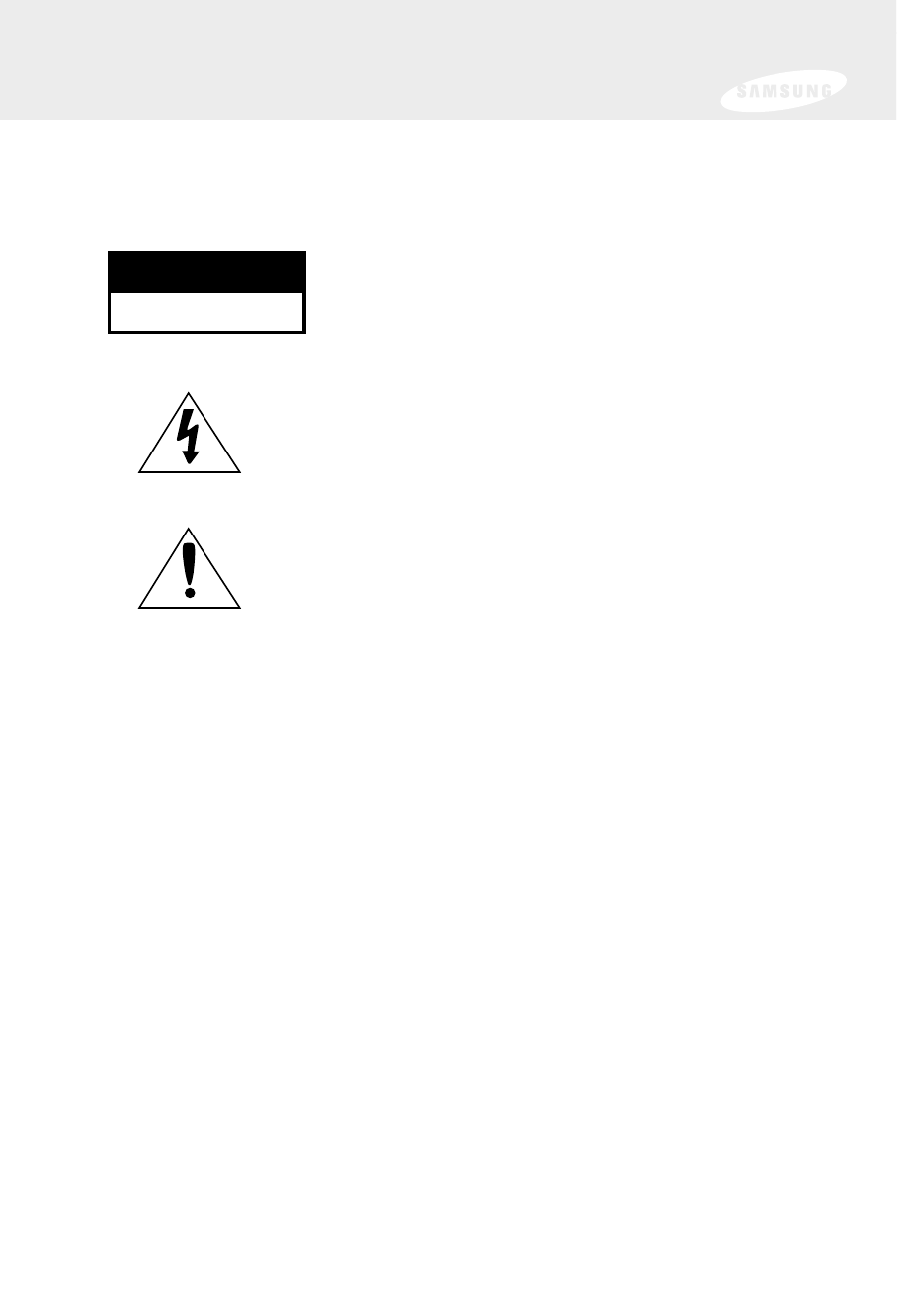
This symbol indicates high voltage is present inside.
It is dangerous to make any kind of contact with any part inside of this product.
This symbol alerts you that important literature concerning operation and
maintenance has been included with this product.
Note to CATV system installer: This reminder is provided to call CATV system installer’s attention to
Article 820-40 of the National Electrical Code that provides guidelines for proper grounding and,
in particular, specifies that the cable ground shall be connected to the grounding system of the
building as close to the point of cable entry as practical.
Caution: FCC regulations state that any unauthorized changes or modifications to this equipment
may void the user’s authority to operate it.
Caution: To prevent electric shock, match the wide blade of plug to the wide slot, and fully insert
the plug.
Important: One Federal Court has held that unauthorized recording of copyrighted TV programs is
an infringement of U.S. copyright laws.
To prevent damage which may result in fire or electric shock hazard, do not expose this appliance to
rain or moisture.
CAUTION
RISK OF ELECTRIC SHOCK
DO NOT OPEN
CAUTION: TO REDUCE THE RISK OF ELECTRIC SHOCK, DO
NOT REMOVE COVER (OR BACK). NO USER
SERVICEABLE PARTS INSIDE. REFER SERVICING TO
QUALIFIED SERVICE PERSONNEL.
Warning! Important Safety Instructions

Warning! Important Safety Instructions
• Read all safety and operating instructions before operating this product.
• Keep the safety and operating instructions for future reference.
• Heed all warnings on the product and in the operating instructions.
• Follow all operating and use instructions.
• Unplug the product from the wall outlet before cleaning. Use a damp cloth; do not use liquid or aerosol
cleaners.
• Never add any attachments and/or equipment without approval of the manufacturer. Such additions can
increase the risk of fire, electric shock, or other personal injury.
• Do not use the product where contact with or immersion in water is a possibility, such as near bath tubs, sinks,
washing machines, swimming pools, etc.
• Do not place the product on an unstable cart, stand, tripod, bracket, or
table where it can fall. A falling product can cause serious injury to a child
or adult, and serious damage to the appliance. Use only with a cart, stand,
tripod, bracket, or table recommended by the manufacturer or sold with
the product. Follow the manufacturer’s instructions when mounting the
unit, and use a mounting accessory recommended by the manufacturer.
Move the product and cart with care. Quick stops, excessive force, and
uneven surfaces can make the unit and cart unsteady and likely to
overturn.
• Provide ventilation for the product. The unit is designed with slots in the
cabinet for ventilation to protect it from overheating. Do not block these
openings with any object, and do not place the product on a bed, sofa, rug, or other similar surface. Do not
place it near a radiator or heat register. If you place the product on a rack or bookcase, ensure that there is
adequate ventilation and that you have followed the manufacturer’s instructions for mounting.
• Operate your product only from the type of power source indicated on the marking label. If you are not sure of
the type of power supplied to your home, consult your appliance dealer or local power company.
• Use only a grounded or polarized outlet. For your safety, this product is equipped with a polarized alternating
current line plug having one blade wider than the other. This plug will fit into the power outlet only one way. If
you are unable to insert the plug fully into the outlet, try reversing the plug. If the plug still does not fit, contact
your electrician to replace your outlet.
• Protect the power cord. Power supply cords should be routed so that they will not be walked on or pinched by
objects placed on or against them. Pay particular attention to cords at plugs, convenience receptacles, and the
point where they exit from the unit.
• Unplug the product from the wall outlet and disconnect the antenna or cabling during a lightning storm or when
left unattended and unused for long periods of time. This will prevent damage to the unit due to lightning and
power-line surges.
Always be careful when using this product. To reduce the risk of fire, electrical shock,
and other injuries, keep these safety precautions in mind when installing, using, and
maintaining your DIRECTV
®
Receiver.
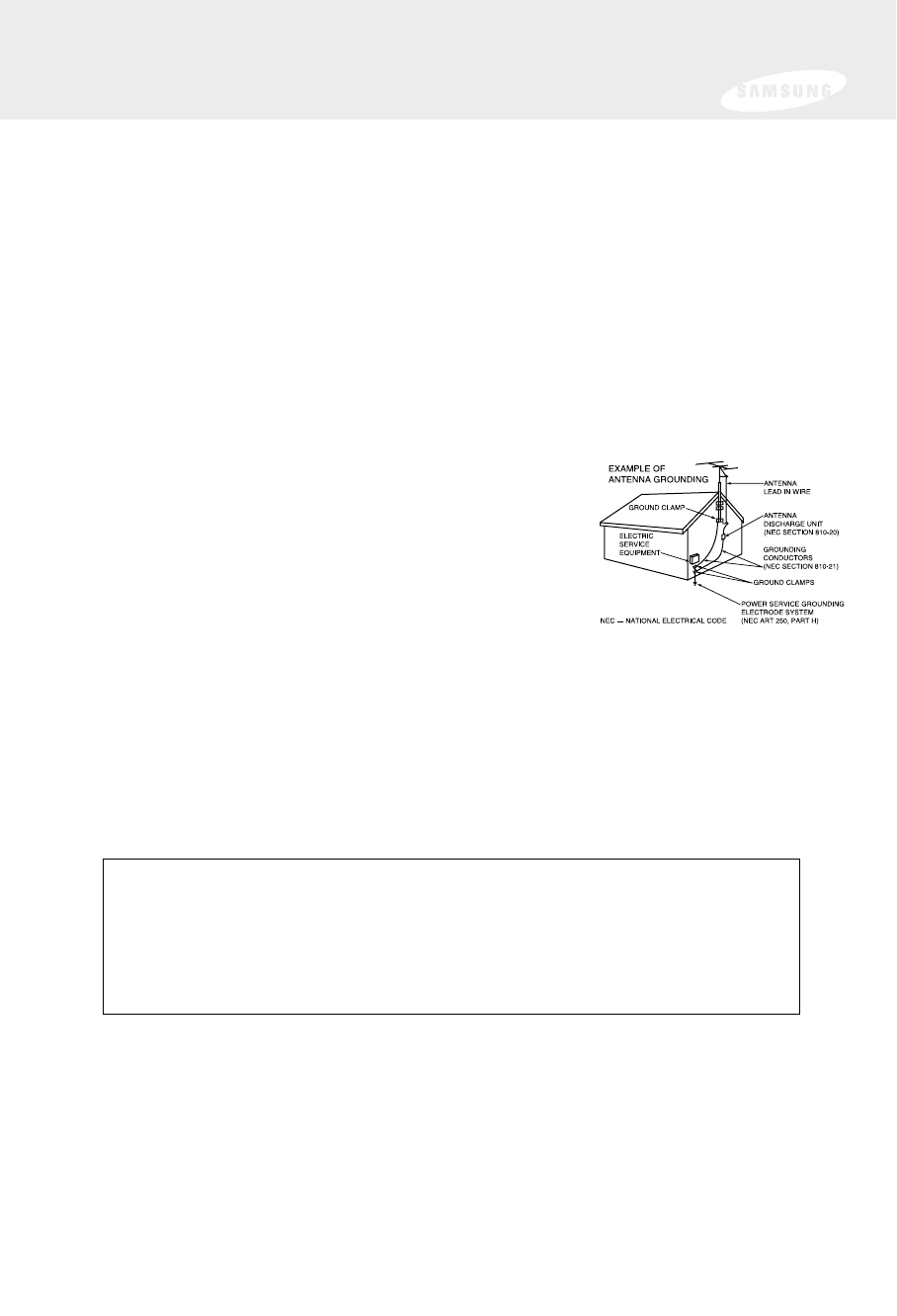
Warning! Important Safety Instructions
Warning! Important Safety Instructions
• Avoid overhead power lines. An outside antenna system should not be placed in the vicinity of
overhead power lines or other electric light or power circuits or where it can fall into such power lines
or circuits. When installing an outside antenna system, be extremely careful to keep from touching the
power lines or circuits. Contact with such lines can be fatal.
• Do not overload the wall outlet or extension cords. Overloading can result in fire or electric shock.
• Do not insert anything through the openings in the unit, where they can touch dangerous voltage
points or damage parts. Never spill liquid of any kind on the product.
• Ground outdoor antennas. If an outside antenna is connected to the product, be sure the antenna is
grounded so as to provide some protection against voltage surges and built-up static charges. Section
810 of the National Electrical Code, ANSI/NFPA No.70-1984, provides information about proper
grounding of the mast and supporting structure, grounding of the lead-in wire to an antenna
discharge unit, size of grounding conductors, location of antenna discharge unit, connection to
grounding electrodes, and requirements for the grounding electrode.
• Do not attempt to service the product yourself. Refer all servicing to qualified service personnel.
Unplug the unit from the wall outlet and refer servicing to qualified service personnel under the
following
conditions:
- when the power-supply cord or plug is damaged
- if liquid has been spilled on the unit or if objects have fallen into
the unit
- if the product has been exposed to rain or water
- if the product does not operate normally by following the
operating instructions
- if the product has been dropped or the cabinet has been damaged
- when the product exhibits a distinct change in performance
• If you make adjustments yourself, adjust only those controls that are covered by the operating
instructions. Adjusting other controls may result in damage and will often require extensive work by a
qualified technician to restore the product to normal.
• When replacement parts are required, be sure the service technician uses replacement parts specified
by the manufacturer or those that have the same characteristics as the original part. Unauthorized
substitutions may result in additional damage to the unit.
• Upon completion of any service or repairs to this product, ask the service technician to perform safety
checks to determine that the product is in a safe operating condition.
This device complies with part 15 of the FCC Rules. Operation is subject to the
following two conditions:
(1) This device may not cause harmful interference, and
(2) This device must accept any interference that may cause undesired operation.
This satellite receiver provides display of television closed captioning in
accordance with §15.119 of the FCC rules.

Notice
AA
AAtt
tttt
ttee
eenn
nntt
ttii
iioo
oonn
nn
Telephone Line Interruption
A continuous land-based phone line connection is required for DIRECTV®Pay Per View
functionality and sports subscriptions. Any calls generated by the DIRECTV Receiver are toll
free. These calls are typically made in the middle of the night; your phone is in use for
approximately 30 seconds.
Trademark and copyright statements
Samsung is a trademark of Samsung Electronics. ©2003 DIRECTV, Inc. DIRECTV, the Cyclone
Design logo and DIRECTV INTERACTIVE are registered trademarks of DIRECTV, Inc., a unit of
Hughes Electronics Corp, and are used with permission. All other trademarks and service
marks are the property of their respective owners.
Manufactured under license from Dolby Laboratories. “Dolby” and the double-D symbol are
trademarks of Dolby Laboratories. Confidential Unpublished Works. ©1992–1997
Dolby Laboratories Inc. All rights reserved.
Macrovision Information
This equipment incorporates copyright protection technology that is protected by U.S. patents
and other intellectual property rights. Use of this copyright protection technology is granted
by Macrovision for home and other limited DBS IRD pay per view uses only. Reverse
engineering or disassembly is prohibited.
Program Recording Restrictions
Programming may be taped for home viewing only. All other taping is expressly prohibited.
Some programming may not be taped. An additional taping fee may be applied. Call your
program provider for details.
OO
OOww
wwnn
nnee
eerr
rr''
''ss
ss
RR
RRee
eecc
ccoo
oorr
rrdd
dd
The model and serial numbers are located on the bottom of the DIRECTV Receiver. The
number for the Access Card is on the back of the card and on the carton label. The Receiver
ID number is on the back of the Receiver. Record these numbers for reference when calling
your sales or service representative regarding this product.
Model Number: ____________________________________
Serial Number: ____________________________________
Access Card Number: ______________________________
Receiver ID Number: ________________________________
CC
CCuu
uuss
sstt
ttoo
oomm
mmee
eerr
rr
SS
SSuu
uupp
pppp
ppoo
oorr
rrtt
tt
For DIRECTV®Programming
For subscription information, or to resolve problems related to programming, call:
DIRECTV at 1-800-DIRECTV (1-800-347-3288) or visit the DIRECTV Web site
(DIRECTV.com).
For Installation
To arrange for the installation of your DIRECTV Receiver, call the dealer from whom
you purchased your system.
For Hardware
To resolve problems related to this DIRECTV Receiver, call
Samsung Customer Support at 1-800-522-2946.

Warranty
SAMSUNG DIGITAL SATELLITE RECEIVER
LIMITED WARRANTY TO ORIGINAL PURCHASER
This SAMSUNG manufactured product, as supplied and distributed by Samsung Electronics
America, Inc. (SAMSUNG) and delivered new, in the original carton to the original
consumer purchaser, is warranted by SAMSUNG against manufacturing defects in
materials and workmanship for a limited warranty period of:
One (1) Year Parts and Labor*
(*90 Days Parts and Labor for Commercial Use)
This limited warranty begins on the original date of purchase, and is valid only on products
purchased and used in the United States. To receive warranty service, the purchaser must
contact SAMSUNG for problem determination and service procedures. Warranty service
can only be performed by a SAMSUNG authorized service center. The original dated bill of
sale must be presented upon request as proof of purchase to SAMSUNG or SAMSUNG’s
authorized service center. Transportation of the product to and from the service center is
the responsibility of the purchaser.
SAMSUNG will repair or replace this product, at our option and at no charge as stipulated
herein, with new or reconditioned parts or products if found to be defective during the
limited warranty period specified above. All replaced parts and products become the
property of SAMSUNG and must be returned to SAMSUNG. Replacement parts and
products assume the remaining original warranty, or ninety (90) days, whichever is longer.
SAMSUNG’s obligations with respect to software products distributed by SAMSUNG under
the SAMSUNG brand name are set forth in the applicable end user license agreement.
Non-SAMSUNG hardware and software products are provided on an “AS IS” basis.
However, non-SAMSUNG manufacturers, suppliers, publishers, and service providers may
provide their own warranties.
This limited warranty covers manufacturing defects in materials and workmanship
encountered in normal, and except to the extent otherwise expressly provided for in this
statement, noncommercial use of this product, and shall not apply to the following,
including, but not limited to: damage which occurs in shipment; delivery and installation;
applications and uses for which this product was not intended; altered product or serial
numbers; cosmetic damage or exterior finish; accidents, abuse, neglect, fire, water,
lightning or other acts of nature; use of products, equipment, systems, utilities, services,
parts, supplies, accessories, applications, installations, repairs, external wiring or connectors
not supplied and authorized by SAMSUNG, or which damage this product or result in
service problems; incorrect electrical line voltage, fluctuations and surges; customer

Warranty
adjustments and failure to follow operating instructions, cleaning, maintenance and
environmental instructions that are covered and prescribed in the instruction book;
product removal or reinstallation; reception problems and distortion related to noise,
echo, interference or other signal transmission and delivery problems. SAMSUNG
does not warrant uninterrupted or error-free operation of the product.
THERE ARE NO EXPRESS WARRANTIES OTHER THAN THOSE LISTED AND DESCRIBED
ABOVE, AND NO WARRANTIES WHETHER EXPRESS OR IMPLIED, INCLUDING, BUT
NOT LIMITED TO, ANY IMPLIED WARRANTIES OF MERCHANTABILITY OR FITNESS
FOR A PARTICULAR PURPOSE, SHALL APPLY AFTER THE EXPRESS WARRANTY
PERIODS STATED ABOVE, AND NO OTHER EXPRESS WARRANTY OR GUARANTY
GIVEN BY ANY PERSON, FIRM OR CORPORATION WITH RESPECT TO THIS PRODUCT
SHALL BE BINDING ON SAMSUNG. SAMSUNG SHALL NOT BE LIABLE FOR LOSS OF
REVENUE OR PROFITS, FAILURE TO REALIZE SAVINGS OR OTHER BENEFITS, OR ANY
OTHER SPECIAL, INCIDENTAL OR CONSEQUENTIAL DAMAGES CAUSED BY THE USE,
MISUSE OR INABILITY TO USE THIS PRODUCT, REGARDLESS OF THE LEGAL THEORY
ON WHICH THE CLAIM IS BASED, AND EVEN IF SAMSUNG HAS BEEN ADVISED OF
THE POSSIBILITY OF SUCH DAMAGES. NOR SHALL RECOVERY OF ANY KIND AGAINST
SAMSUNG BE GREATER IN AMOUNT THAN THE PURCHASE PRICE OF THE PRODUCT
SOLD BY SAMSUNG AND CAUSING THE ALLEGED DAMAGE. WITHOUT LIMITING THE
FOREGOING, PURCHASER ASSUMES ALL RISK AND LIABILITY FOR LOSS, DAMAGE OR
INJURY TO PURCHASER AND PURCHASER’S PROPERTY AND TO OTHERS AND THEIR
PROPERTY ARISING OUT OF THE USE, MISUSE OR INABILITY TO USE THIS PRODUCT
SOLD BY SAMSUNG NOT CAUSED DIRECTLY BY THE NEGLIGENCE OF SAMSUNG.
THIS LIMITED WARRANTY SHALL NOT EXTEND TO ANYONE OTHER THAN THE
ORIGINAL PURCHASER OF THIS PRODUCT, IS NONTRANSFERABLE AND STATES YOUR
EXCLUSIVE REMEDY.
Some states do not allow limitations on how long an implied warranty lasts, or the
exclusion or limitation of incidental or consequential damages, so the above limitations
or exclusions may not apply to you. This warranty gives you specific legal rights, and you
may also have other rights which vary from state to state.
To obtain warranty hardware service, please contact SAMSUNG at:
SAMSUNG CUSTOMER SERVICE
400 VALLEY ROAD, SUITE 201, MT ARLINGTON, NJ 07856, TEL: 973-601-6000, FAX: 973-601-6001
1-800-522-2946 and SAMSUNGUSA.COM 061501

Table of Contents
Chapter 1: Getting Started ......................................................................5
Box contents ...................................................................................5
Front panel controls and lights ........................................................7
Back of the DIRECTV Receiver ........................................................9
Installing the batteries in the remote control...................................11
Inserting the Access card ...............................................................12
Chapter 2: Setting up and connecting ..................................................13
Jacks and cables ............................................................................13
Before making connections ............................................................15
Choosing a connection ..................................................................16
Connection option A: ................................................................... 17
DIRECTV Receiver to TV with RF cable only
Connection option B: .....................................................................19
DIRECTV Receiver to TV with A/V cables
Connection option C: ....................................................................21
DIRECTV Receiver to TV and VCR with RF cables only
Connection option D: ....................................................................23
DIRECTV Receiver to TV and VCR with A/V cables
Connection option E: .....................................................................25
DIRECTV Receiver to TV and A/V receiver
Connection option F: .....................................................................27
DIRECTV Receiver to TV with
Component Video inputs and digital A/V receiver
Connecting the VCR control cable (model SIR-S310W only)..........29
Turning on the DIRECTV Receiver for the first time........................29
Adjusting up the satellite dish.........................................................30
Testing your DIRECTV Receiver......................................................36
Activating your DIRECTV account..................................................38
Upgrades........................................................................................38
1

Chapter 3: Watching TV........................................................................39
Remote control overview................................................................39
Changing channels.........................................................................41
Adjusting the volume .....................................................................41
Getting help ...................................................................................41
Getting information on the TV program you are watching.............41
Finding out what’s on: the Guides..................................................45
Searching for programs in the Guide..............................................54
Choosing an alternate audio format for a program.........................57
Changing the User setting..............................................................57
Pay per view programs...................................................................58
Chapter 4: Program reminders and recording timers.............................63
Setting up the VCR control (model SIR-S310W only).....................63
Scheduling program reminders and recording timers ......................65
Reviewing and modifying reminders and recording timers..............66
Chapter 5: User profiles.........................................................................69
User profiles basics .........................................................................69
Editing user profile names...............................................................70
Editing channel lists ........................................................................72
Setting ratings limits .......................................................................74
Allowing or blocking pay per view purchases .................................80
Setting a pay per view spending limit.............................................81
Setting the screen color and translucency.......................................82
Setting the current user profile .......................................................83
Locking and unlocking your DIRECTV System................................83
2

Table of Contents
Chapter 6: Settings, preferences, upgrades, and extras.........................85
Reading your mail ..........................................................................85
Setting system preferences .............................................................86
Reviewing and controlling caller ID ................................................92
Setting the Local Time options.......................................................94
Installing a new Access Card ..........................................................96
Viewing important information and a list of features .....................97
supported by your DIRECTV Receiver
Viewing information on automatic system upgrades ......................99
Viewing fun system extras............................................................100
Chapter 7: Programming the remote control.......................................101
Programming the remote control..................................................101
Operating a device with your programmed remote control..........102
Code lists......................................................................................103
3

Chapter 8: Troubleshooting .................................................................109
Appendix: Specifications......................................................................111
Specifications for DIRECTV Receiver model SIR-S300W...............111
Specifications for DIRECTV Receiver model SIR-S310W...............112
Index....................................................................................................113
4
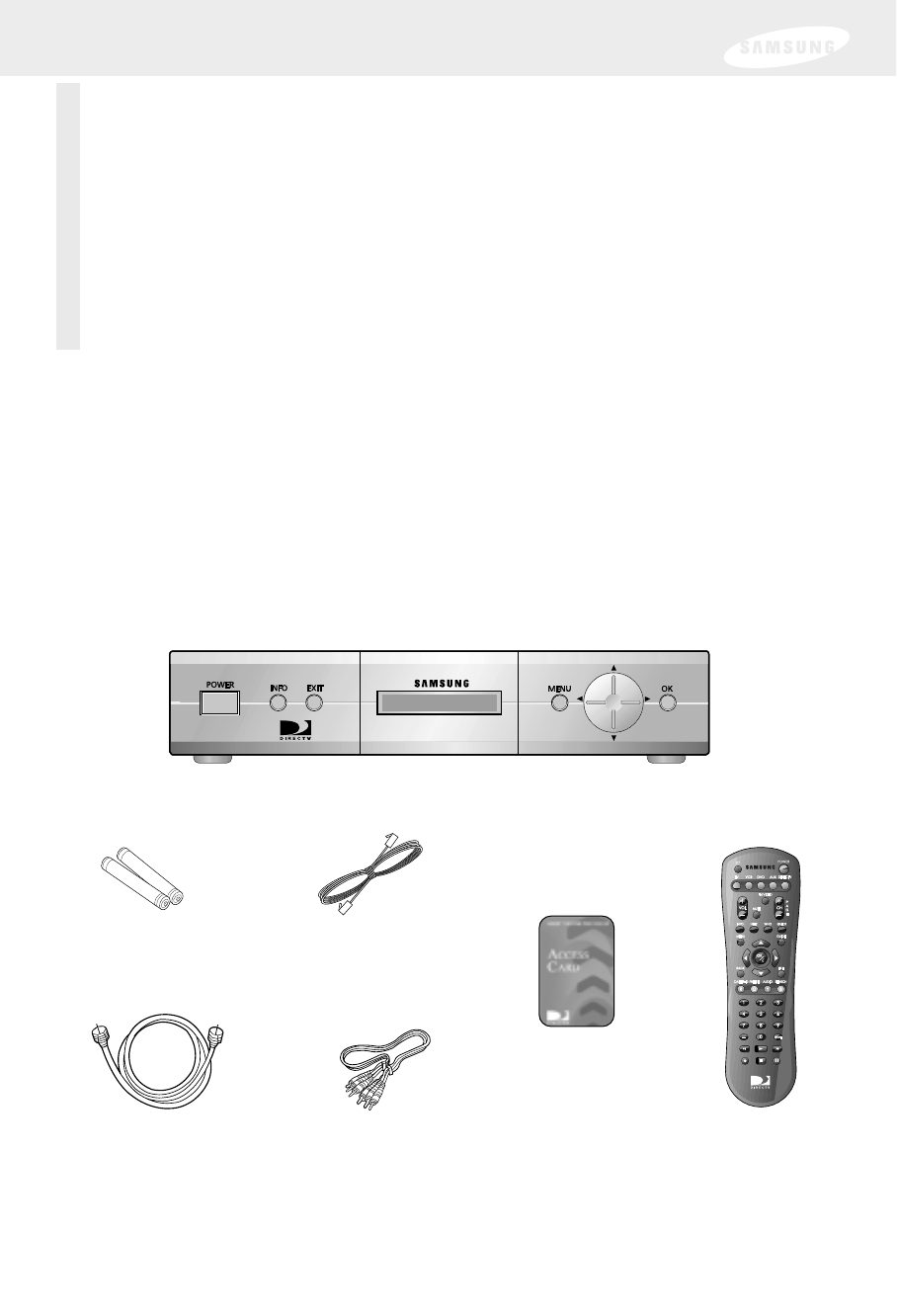
Chapter 1: Getting started
This chapter tells you everything you need to know before you start setting up and
using your DIRECTV Receiver. It includes information on:
•Box contents
•Front panel controls and lights
•Back of the DIRECTV Receiver
•Installing the batteries in the remote control
•Inserting the Access Card
5
Box contents
Welcome! The first step in setting up your DIRECTV Receiver is to unpack the box
and familiarize yourself with its contents. This manual covers two models of
DIRECTV Receiver: the SIR-S300W and the SIR-S310W
DIRECTV Receiver (SIR-S300W)
RJ-11
Telephone cord
A/V cable Remote control
Access Card
AAA size batteries
RF coaxial cable
Box contents for the SIR-S300W
If you are missing any items, contact your Samsung dealer.
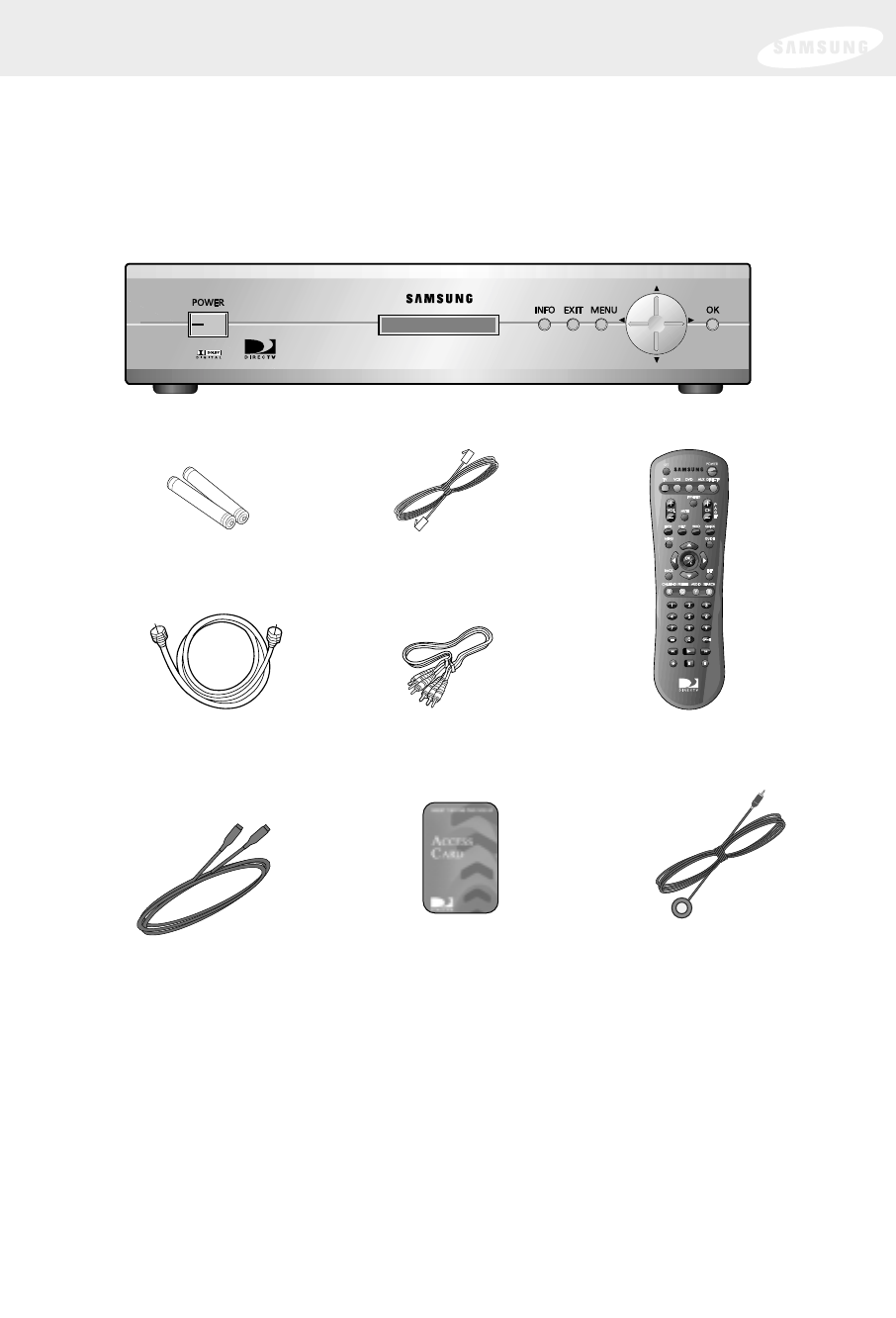
6
Box contents for the SIR-S310W
If you are missing any items, contact your Samsung dealer.
AAA size batteries
DIRECTV Receiver (SIR-S310W)
RJ-11
Telephone cord
A/V cable Remote control
RF coaxial cable
Access Card VCR control cable
S-Video cable
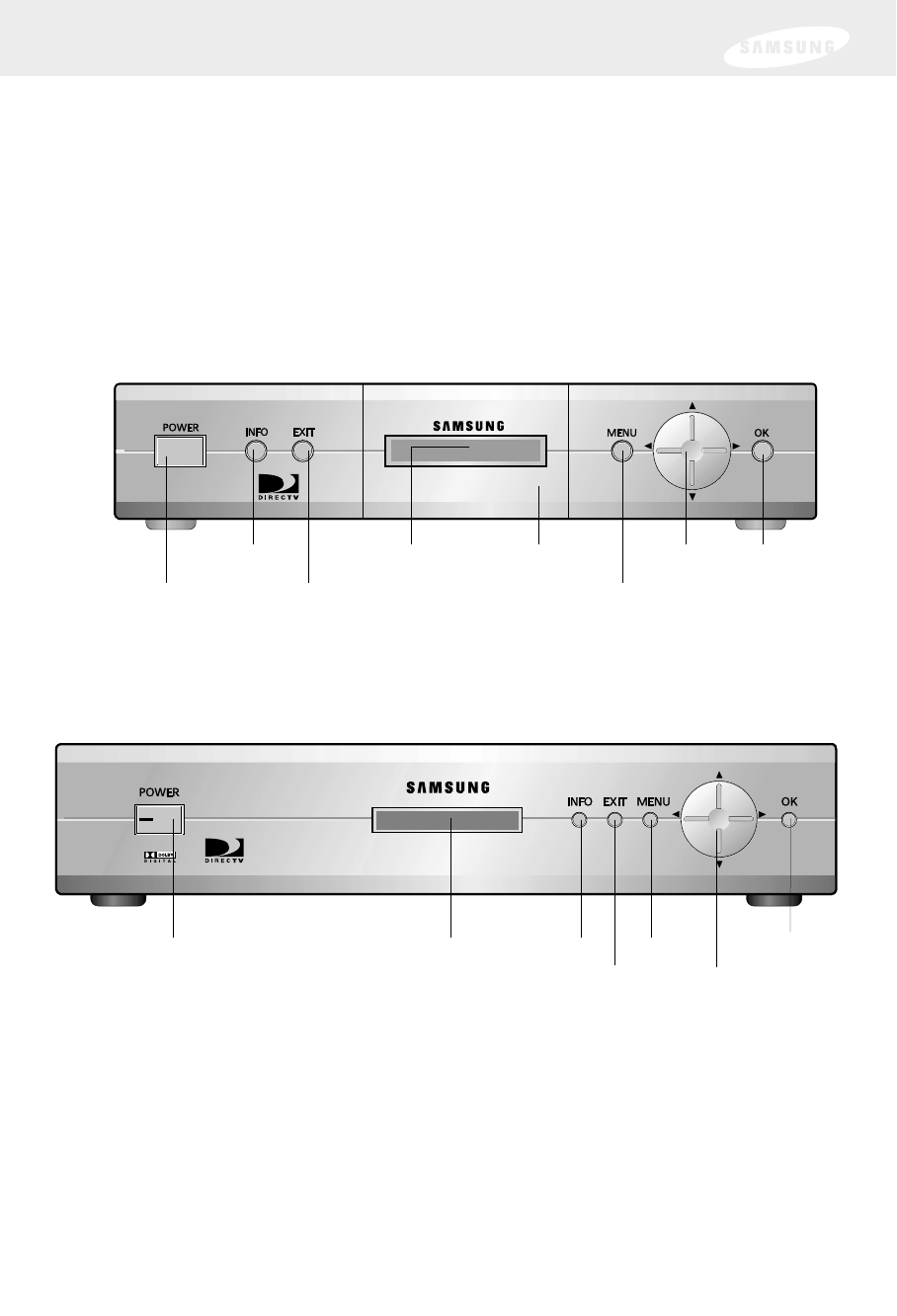
Chapter 1: Getting started
7
Front panel controls and lights
Now that you’ve unpacked the box, take a moment to take a look at the
buttons and lights on the front of your DIRECTV Receiver.
POWER button
and light
OK
MenuEXIT
ArrowsRemote
control sensor
INFO
SIR-S310W
SIR-S300W
POWER button
and light OKMenu
EXIT Arrows
Remote control sensor INFO
Access Card
door

Chapter 1: Getting started
8
POWER Button and light
Push this button to turn your DIRECTV Receiver on or off. The light glows when
power is on.
Remote control sensor
Point your remote control at this sensor when operating your receiver.
Access Card door (Model SIR-S300W only)
This door covers the Access Card slot. This slot holds the Access Card (which allows
you to view DIRECTV®programming). The Access Card slot is on the rear panel on
model SIR-S310W.
INFO
Push this button to display TV program information.
EXIT
Push this button to clear on-screen displays and return to TV program viewing.
MENU
Push this button to display the Main Menu.
Arrows
Push these buttons to navigate left, right, up, or down in the on-screen Guide and
menu system.
OK
Push this button to select a highlighted item in the on-screen Guide and menu system.
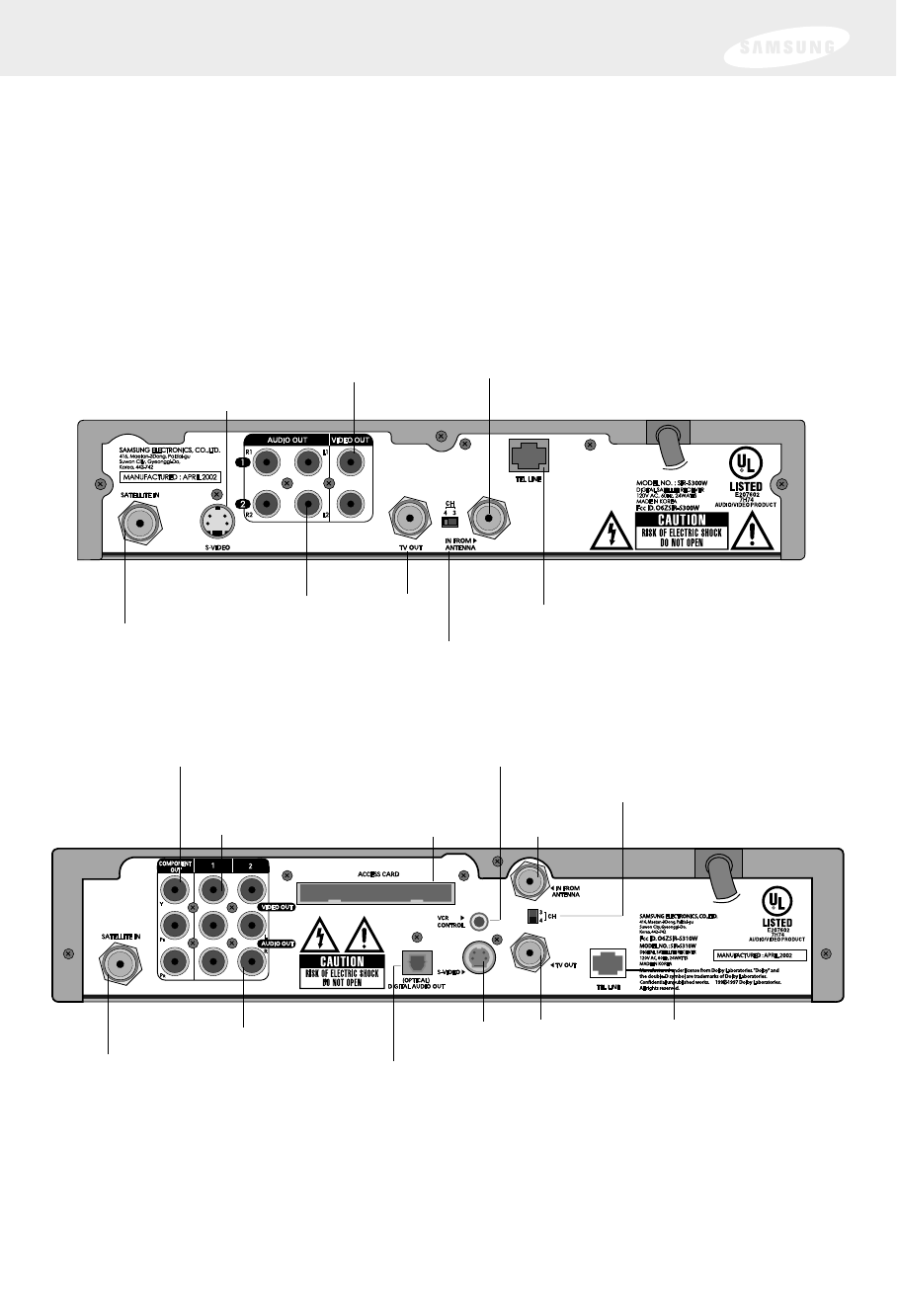
Chapter 1: Getting started
9
Back of the DIRECTV Receiver
The diagram below illustrates the location of the input and output jacks on the
back of the receiver. These illustrations may help you as you set up your
DIRECTV Receiver. Step-by-step setup instructions appear in Chapter 2.
Antenna In
Video Out
Channel 3/4 switch
VCR control
Telephone lineS-VIDEO Out
Digital Audio Out
TV OUT
Access Card slot
Audio Out
Component Out(Y, Pb, Pr video)
SATELLITE IN
SIR-S310W
SIR-S300W Antenna InVideo Out
SATELLITE IN Channel 3/4 switch
Telephone line
S-VIDEO Out
TV OUT
Audio Out

Chapter 1: Getting started
10
Satellite In
The RG-6 cable from the satellite dish connects to this jack.
Antenna In
The cable from an off-air TV antenna (not from the satellite dish) connects to
this jack.
Video Out
Using a standard video cable, this jack connects your DIRECTV Receiver to
your TV or VCR.
Audio Out
Using standard stereo audio cables, these jacks connect the DIRECTV
Receiver to your TV or VCR.
S-Video Out
This jack connects your DIRECTV Receiver to a TV or VCR that accepts
S-Video input.
Component Out (Y, Pb, Pr video) (SIR-S310W only)
Using standard A/V cables, these jacks connect your DIRECTV Receiver to a
TV or VCR that accepts high-quality (“component”) video input.
Digital audio out (SIR-S310W only)
Using an optical digital audio cable, this jack allows you to connect your
DIRECTV Receiver to an audio receiver that accepts optical digital audio
input.
TV Out
Using an RF coaxial cable, this jack connects the DIRECTV Receiver to your
TV or VCR.
Channel 3/4 switch
This switch sets the channel for viewing the TV Out signal on your TV.
Telephone line
A telephone line connected to this jack allows you to order
pay per view programming.
VCR control (SIR-S310W only)
The VCR control cable connects to this jack.
Access Card slot (model SIR-S310W only)
This slot holds the Access Card (which allows you to view
DIRECTV®programming). The Access Card slot is behind the Access Card
door on the front of model SIR-S300W.
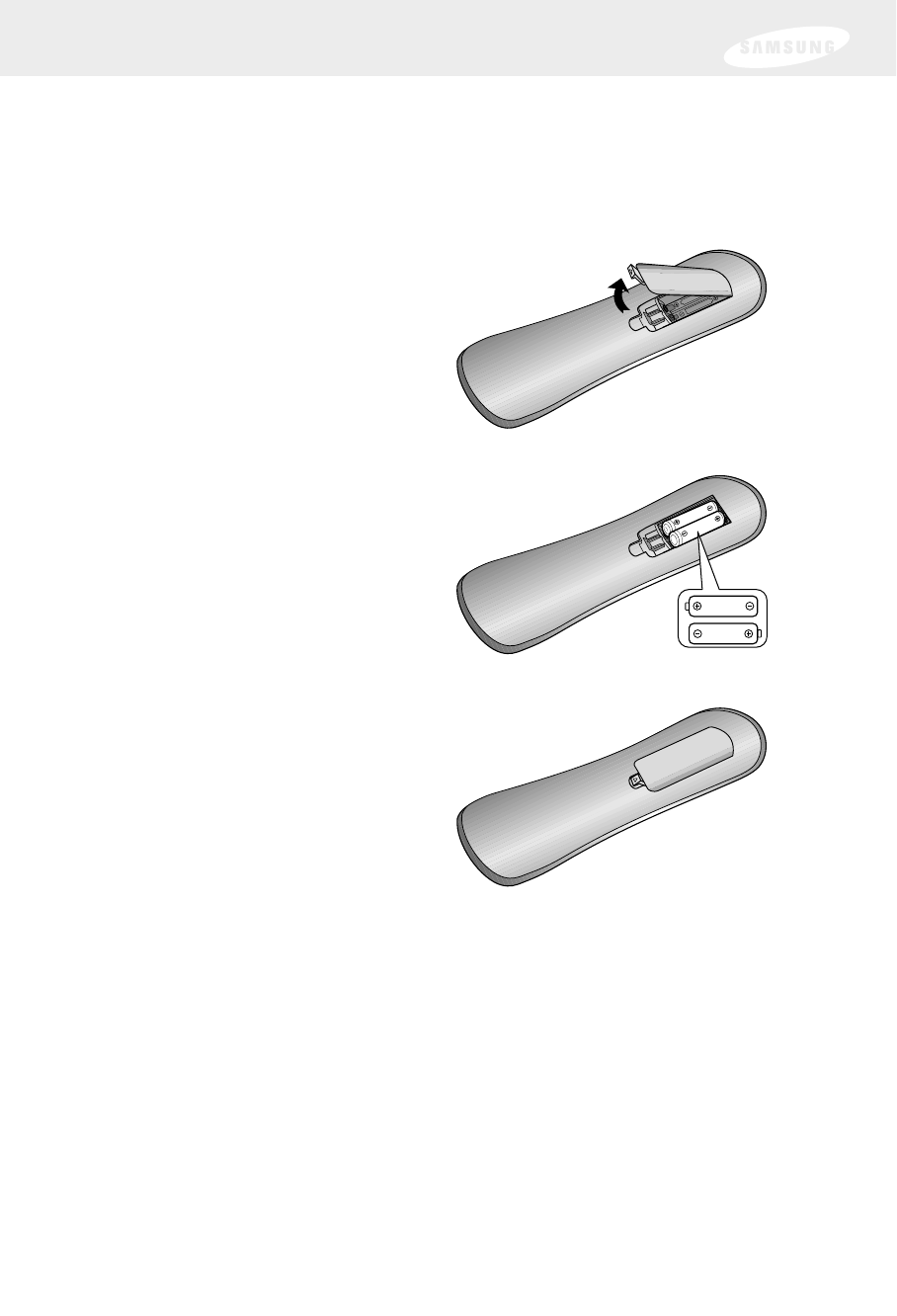
Installing the batteries in the remote control
You’ve unpacked the receiver and reviewed its front and back panels. Now it’s time to
start setting up. The first step is to install the batteries in your remote control.
1 Unlatch the battery compartment cover
on the back of remote control.
2 Insert 2 AAA batteries as shown,
making sure the + and – ends of each
battery line up with the corresponding
marks in the battery compartment.
3Snap the cover back onto the remote
control.
4Test the remote control to make sure the batteries have been inserted correctly. Press
the DIRECTV button and make sure the button lights up. If it does not light up,
check the orientation of the batteries.
Note: Alkaline batteries are strongly recommended for this remote control.
Chapter 1: Getting started
11
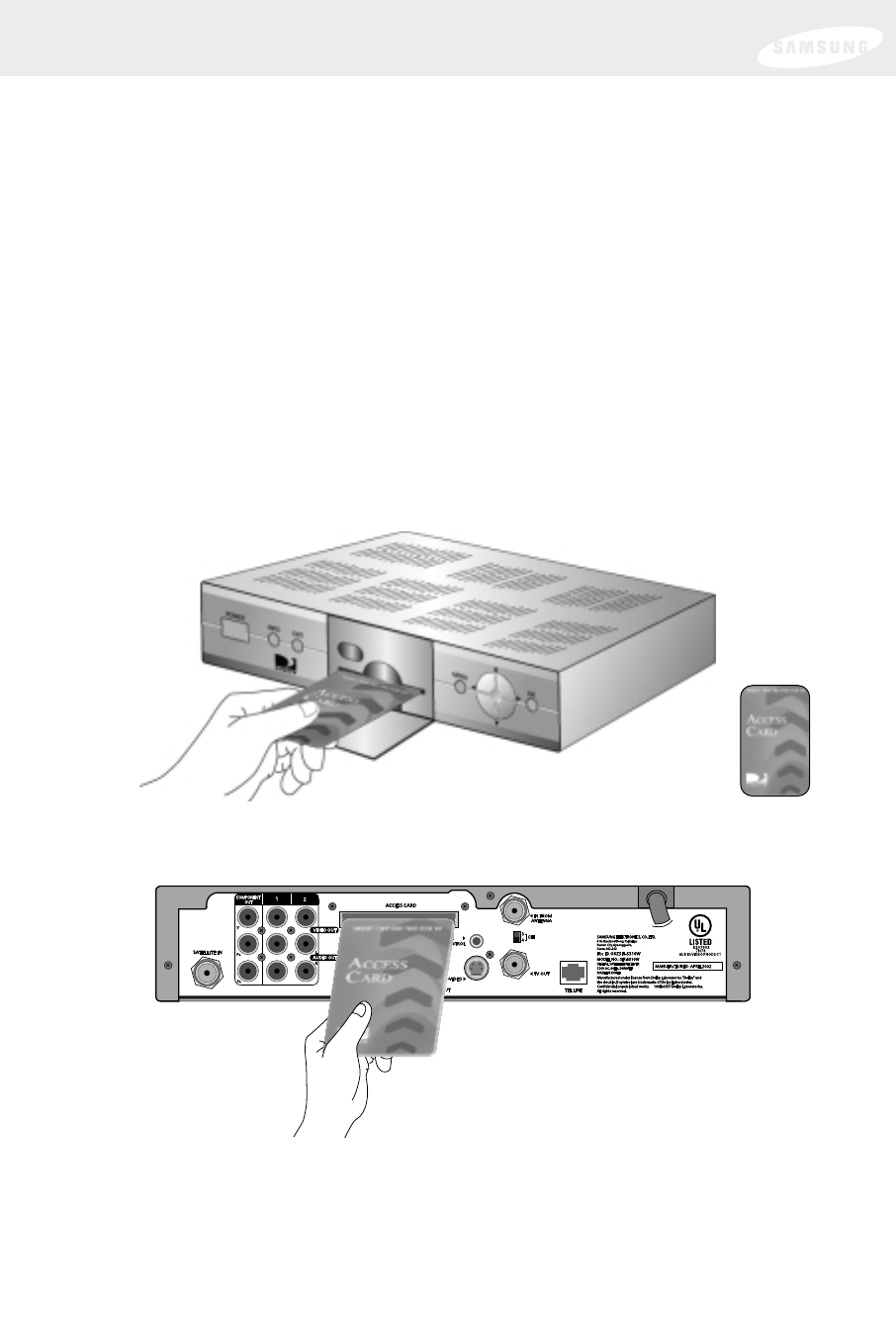
Chapter 1: Getting started
12
Inserting the Access Card
The next step is to insert your Access Card into your receiver. (You will not be able to view
DIRECTV®programming unless the Access Card is properly inserted into the DIRECTV
Receiver.) For some receivers, the card may already be inserted when you unpack the box.
1Locate the ACCESS CARD slot.
On model SIR-S300W the slot is located on the front of the DIRECTV Receiver,
behind the Access Card door.
On model SIRS310W the slot is located on the back of the DIRECTV Receiver.
2Insert the Access Card.
Make sure the side with the bar code is facing down, and the arrow is pointing away
from you.
The Access Card should only be removed when replacing the card with a new one
provided by DIRECTV or your program provider.
Model SIR-S300W
Model SIR-S310W Access Card
(Top view)
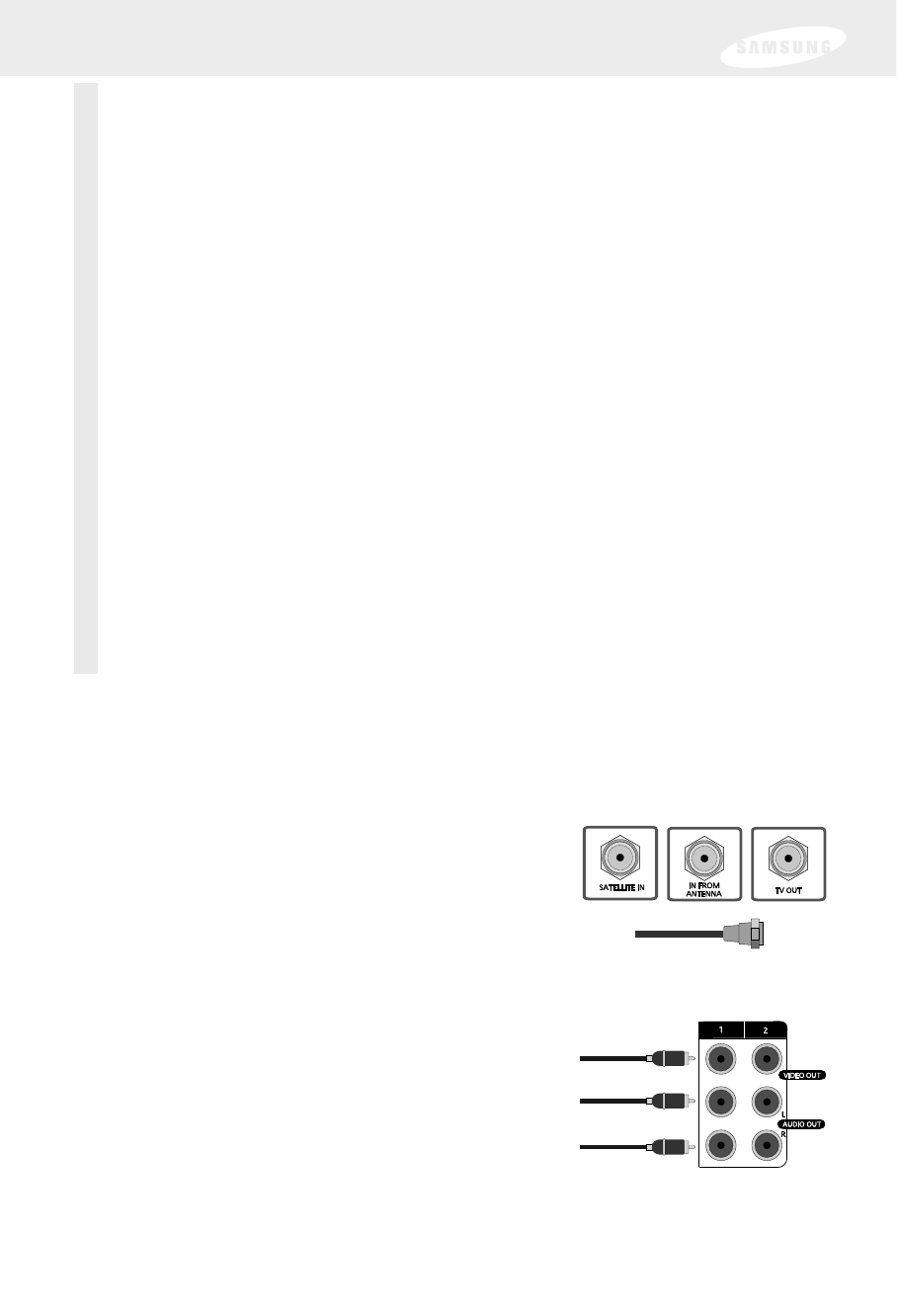
13
Jacks and cables
The illustrations on these pages show the various types of jacks and cables used to
connect your DIRECTV Receiver. If you are unfamiliar with these jacks and cables,
take a moment to review them before starting the step-by-step connection process.
RF jacks and coaxial cable
The TV OUT RF jack on the DIRECTV Receiver uses a
coaxial cable to connect to your TV or VCR. This jack
provides monaural sound and a good TV picture. An
RF jack is also used for TV antenna connection (IN
FROM ANTENNA), and using an RG-6 coaxial cable,
for the satellite dish (SATELLITE IN) input connection.
Audio/Video jacks and cables (RCA-type)
Audio/Video jacks and cables provide stereo sound
and a better TV picture than RF jacks and cables. Use
these jacks and cables to connect your receiver to a
TV, VCR, or to other components such as a stereo
receiver or amplifier. The audio/video jacks on the
back of the receiver and the audio/video cable
connectors are color coded (yellow for video, red for
right audio, and white for left audio).
Chapter 2: Setting up and connecting
This chapter explains how to setup and start using your DIRECTV Receiver.
Contents include:
•Jacks and cables
•Before making connections
•Choosing a connection
•Connection option A: DIRECTV Receiver to TV with RF cable only
•Connection option B: DIRECTV Receiver to TV with A/V cables
•Connection option C: DIRECTV Receiver to TV and VCR with
RF cables only
•Connection option D: DIRECTV Receiver to TV and VCR with A/V cables
•Connection option E: DIRECTV Receiver to TV and A/V receiver
•Connection option F (SIR-S310W only): DIRECTV Receiver to TV with
Component Video inputs and digital A/V receiver
•Connecting the VCR control cable (model SIR-S310W only)
•Turning on the DIRECTV Receiver for the first time
•Adjusting the satellite dish
•Testing your DIRECTV Receiver
•Activating the DIRECTV account
•DIRECTV®service upgrades
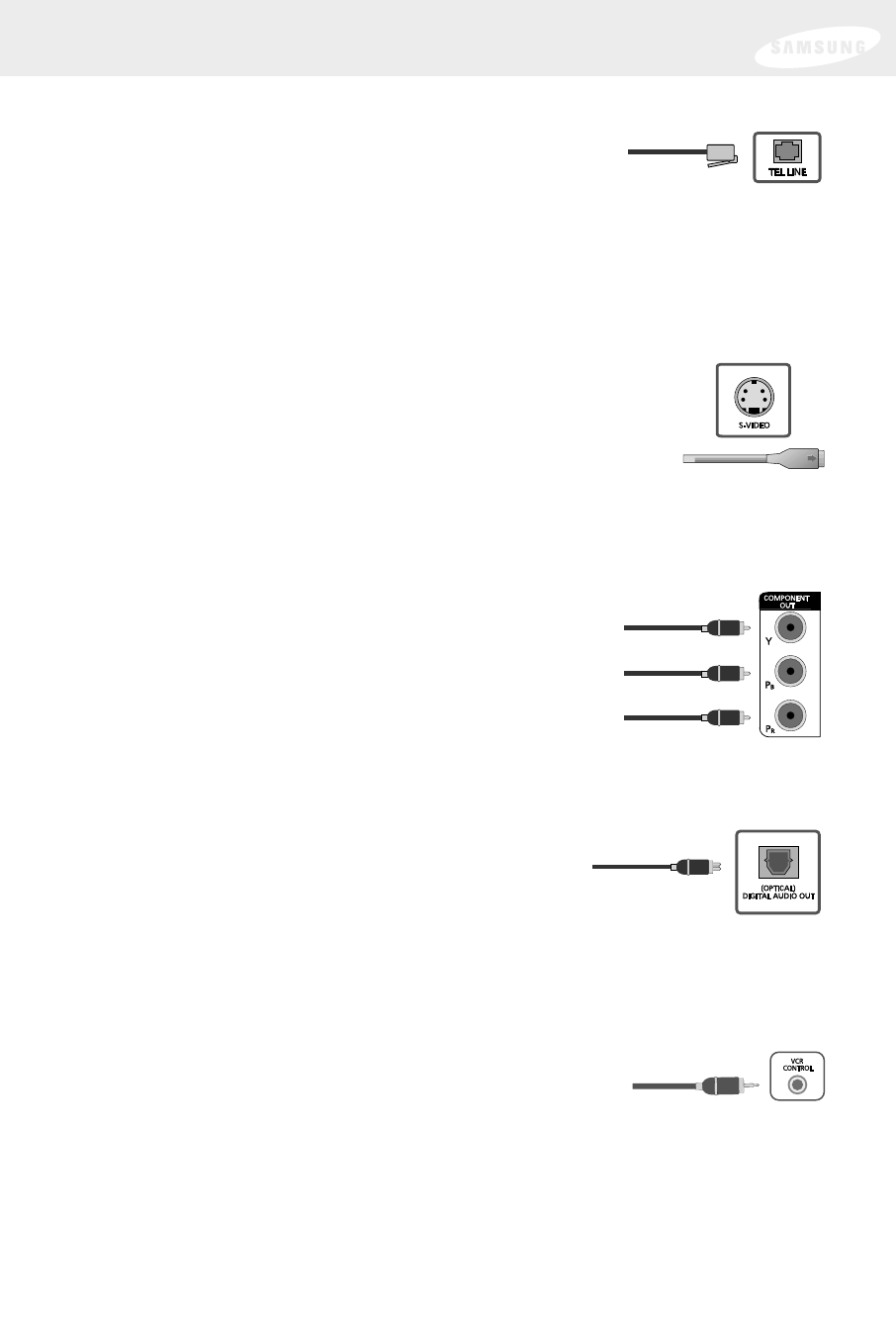
14
Telephone jack and cord
The TEL LINE jack and the included telephone cord connect
your DIRECTV Receiver to a phone line. If your home does
not have RJ-11 type phone jacks, please contact your phone
company to get one installed.
A continuous land-based phone line connection is required for DIRECTV®Pay Per
View functionality and Sports subscriptions. Any calls generated by the DIRECTV
Receiver are toll-free. These calls are typically made in the middle of the night; your
phone is in use for approximately 30 seconds.
S-Video jack and cable (cable included with model SIR-S310W only)
S-Video cables and jacks are used to connect the DIRECTV
Receiver to TVs, VCRs, and other video equipment equipped
with S-Video input jacks. S-Video connections provide a high-
quality TV picture (better than RCA-type A/V jacks and cables).
Unlike the round RCA-type connectors, S-Video connectors
must be correctly aligned before you can plug in the cable. (This
cable carries the video signal only; use with A/V cables for the audio signal.)
Component video jacks and cables (cable not included, jack on model
SIR-S310W only)
The three-cable component video cables and jacks (also
referred to as “Y, Pb, Pr”) are used to connect the
DIRECTV Receiver to TVs, VCRs, A/V receivers and other
video equipment equipped with component video input
jacks. Component video connections provide a TV picture
superior to S-Video connections. (These cables carry the
video signal only; use with A/V cables for the audio signal.)
Optical digital audio jack and cable (cable not included, jack on model
SIR-S310W only)
Optical digital jacks and cables use light to send digital
audio data to A/V receivers equipped to receive and
interpret this data. The uniquely shaped connectors on
the jacks and cables must be aligned before you can
plug in the cable. (Note that the jacks and cables may
be covered by protective caps which you must remove
before making the connection.)
VCR control jack and cable (jack and cable included on SIR-S310W only)
The VCR control jack and cable allow your model
SIR-S310W DIRECTV Receiver to send signals to your VCR’s
remote sensor, giving you the ability to program your VCR
to tape programs for you using simple on-screen controls.

Before making connections
The next steps are to determine which connection option you should use and then to
make the necessary connections. Before you begin, please note the following
important safety and setup tips.
Protect your components from power surges
• Always turn off and unplug your DIRECTV Receiver, TV, and any other
components before connecting or disconnecting any of the cables.
Position all cables correctly to avoid audio hum
or interference
• After connecting the components, please run the audio/video cables along the
side of the TV set, rather than straight down the back of the TV.
• Make sure that all cables are plugged or screwed tightly into their jacks.
• Please make sure that all antennas and cables are properly grounded.
• Whenever possible, route audio and video cables away from power cords.
Protect your components from overheating
• Do not block ventilation holes in the top of the DIRECTV Receiver, or any other
components. Make sure to position the components so that air can circulate
freely.
• If you are positioning the components in a stand or rack, make sure to allow for
proper ventilation.
• Do not stack components.
• If you have a stereo amplifier or receiver as a system component, please place it
on the top shelf or top rack so that hot air rising from it will not flow around other
components.
Make strong connections
• Make sure you securely connect cables when making connections. When a tight
fit makes a secure connection difficult, you can sometimes make it easier by
gently twisting the cable-end while pushing it onto the jack. (Important: never
twist S-Video or Optical Digital Audio cables — they have specially shaped ends
that must be correctly oriented before connecting.)
Avoid cable damage
• Never kink, bend, or twist optical digital audio cables; doing so might break the
fragile optical fibers they contain, rendering them unable to carry a signal.
Chapter 2: Setting up and connecting
15

Chapter 2: Setting up and connecting
16
Choosing a connection
Your DIRECTV Receiver supports a variety of connection possibilities to ensure that
it is compatible with whatever type of TV, VCR, or A/V receiver you might have.
This manual describes six different setup possibilities in detail. The one that is right
for you depends on what type of A/V equipment you have in addition to your
DIRECTV Receiver. To get the best audio and video possible with your particular set
of A/V equipment, use these pages to choose the connection option that most
closely matches your situation.
Option A: DIRECTV Receiver to TV with RF cable only
Option A is the most simple setup option. If you are not planning on
using a VCR and your TV has no A/V connectors, use this option.
(Turn to page 17 now.)
Option B: DIRECTV Receiver to TV with A/V cables
Option B is also for people not planning on using a VCR, but this
option improves the sound and video quality by making the
connections using A/V cables. If you are not planning to use a VCR,
but your TV does have RCA-type A/V input jacks, use connection
Option B. (Turn to page 19 now.)
Option C: DIRECTV Receiver to TV and VCR with RF cables only
Option C is the simplest connection option that includes a VCR. If you
want to connect your DIRECTV Receiver to a TV and VCR, and your
TV or VCR does not have A/V jacks, use connection Option C. (Turn
to page 21 now.)
Option D: DIRECTV Receiver to TV and VCR with A/V cables
Option D also allows you to connect the DIRECTV Receiver to a TV
and VCR, but Option D provides improved sound and video quality
over Option C. If you are planning to connect your DIRECTV Receiver
to a TV and VCR which both have A/V jacks,use connection Option
D. (Turn to page 23 now.)
Option E: DIRECTV Receiver to TV and A/V receiver
Option E shows you how to connect the DIRECTV Receiver to an A/V
system that includes an A/V receiver. If you plan to use an A/V
receiver with your DIRECTV Receiver and TV, use connection Option
E. (Turn to page 25 now.)
Option F: DIRECTV Receiver to TV with component video inputs and
Digital A/V receiver (SIR-S310W only)
Option F also shows you how to connect the DIRECTV Receiver to an
A/V setup that includes a TV and an A/V receiver. In Option F,
however, the A/V receiver supports optical digital audio input, and the
TV supports component (Y, Pb, Pr) video input. If this matches your
situation, use connection Option F. (Turn to page 27 now.)

Chapter 2: Setting up and connecting
17
Connection option A:
DIRECTV Receiver to TV with RF cable only
If connection option A best matches your needs,
follow these steps:
1Make sure your TV and DIRECTV Receiver are turned off and unplugged.
2Connect the RG-6 coaxial cable running from your satellite dish to the
SATELLITE IN jack on the back of your DIRECTV Receiver.
3Connect the coaxial cable running from your cable TV system or
off-air TV antenna to the IN FROM ANTENNA jack on the back of
the DIRECTV Receiver.
4Connect the supplied phone cord to a telephone wall jack and to the
TEL LINE jack on the back of the DIRECTV Receiver.
5Connect the supplied coaxial cable to the Antenna In jack on your TV and to
the TV OUT jack on the back of the DIRECTV Receiver.
6Plug in the power cords for your DIRECTV Receiver and TV.
To watch DIRECTV®programming
To watch DIRECTV®programming, tune your TV to channel 3 or 4 (depending
on the position of the CH 3/4 switch on the back of your DIRECTV Receiver).
Channel 3 is the default setting.
Next Step
Now turn to page 29 to start using your DIRECTV Receiver.
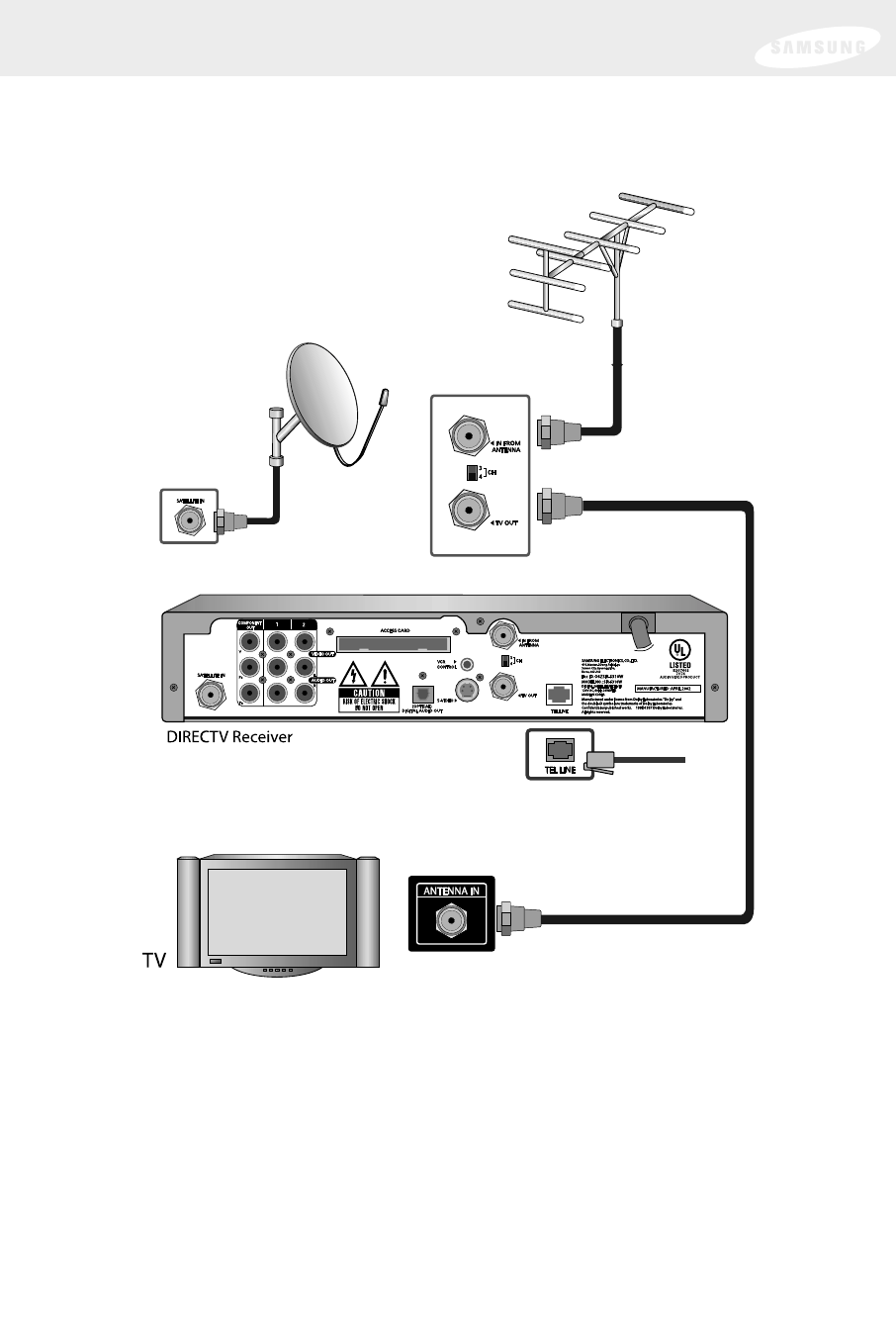
Chapter 2: Setting up and connecting
18
Note: DIRECTV Receiver model SIR-S310W shown;
connections are the same for model SIR-S300W.

Chapter 2: Setting up and connecting
19
Connection option B:
DIRECTV Receiver to TV with A/V cables
If connection option B best matches your needs,
follow these steps:
1Make sure your TV and DIRECTV Receiver are turned off and unplugged.
2Connect the RG-6 coaxial cable running from your satellite dish to the
SATELLITE IN jack on the back of your DIRECTV Receiver.
3Connect the coaxial cable running from your cable TV system or
off-air TV antenna to the IN FROM ANTENNA jack on the back of
the DIRECTV Receiver.
4Connect the supplied phone cord to a telephone wall jack and to the
TEL LINE jack on the back of the DIRECTV Receiver.
5Matching like colors, connect the supplied A/V cable to the AUDIO OUT
and VIDEO OUT jacks on the back of the DIRECTV Receiver.
6Connect the other ends of the A/V cables to the audio and video input jacks
on your TV. Be sure to connect the outputs on the DIRECTV Receiver to
corresponding inputs on your TV (video out to video in, left audio out to left
audio in, right audio out to right audio in).
7(Optional) if your TV has an S-Video input jack, connect one end of an S-
Video cable to the S-VIDEO jack on the back of the DIRECTV Receiver.
Connect the other end of this cable to the S-Video In jack on the back of
your TV. This step is optional; it provides improved picture quality on
some TVs.
8Plug in the power cords for your DIRECTV Receiver and TV.
To watch DIRECTV®programming
Set your TV to the appropriate input mode. This is a setting on your TV usually
controlled by a Video, Input, or Mode button. See the manual for your TV for
instructions.
Next Step
Now turn to page 29 to start using your DIRECTV Receiver.
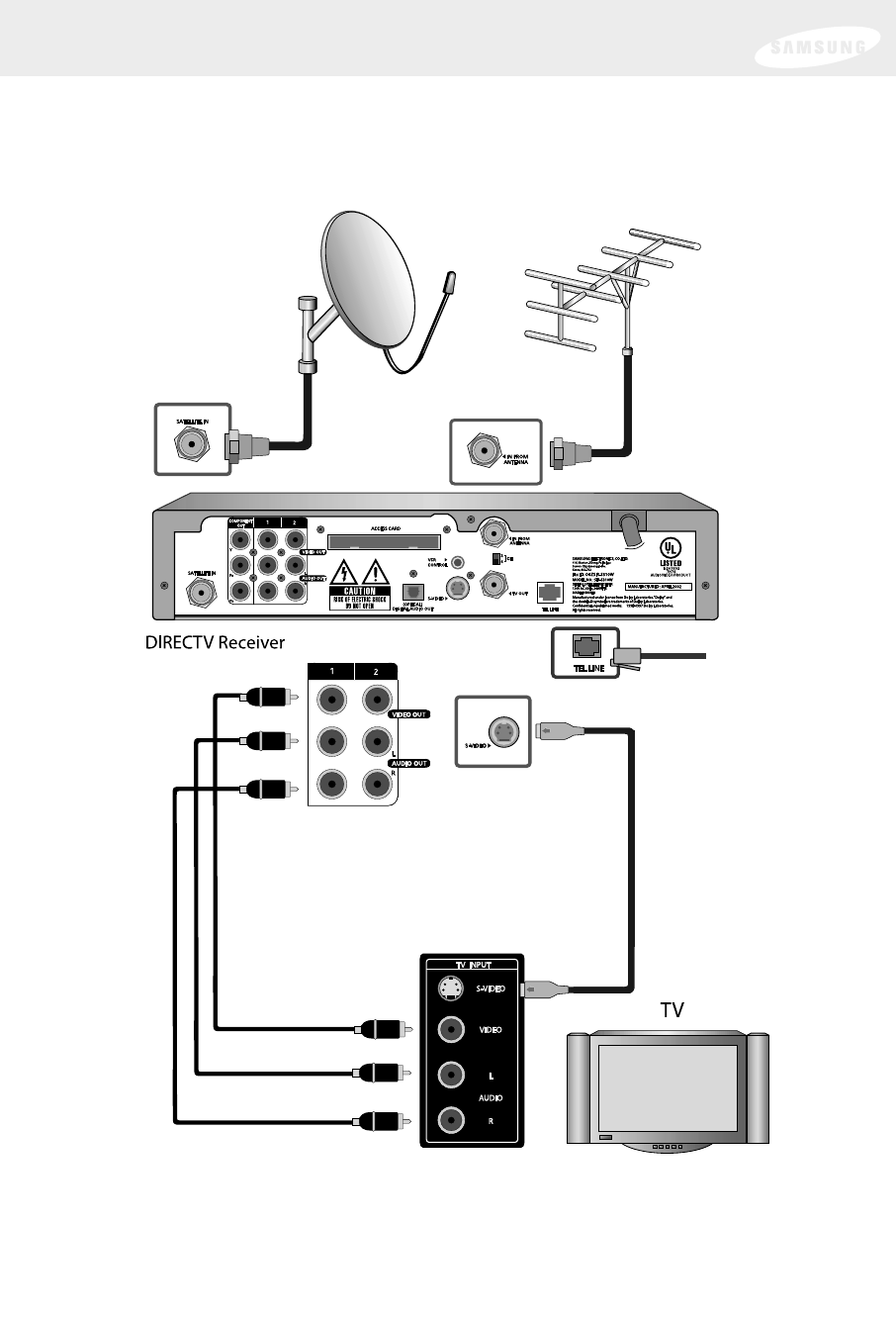
Chapter 2: Setting up and connecting
20
Note: DIRECTV Receiver model SIR-S310W shown;
connections are the same for model SIR-S300W.

Chapter 2: Setting up and connecting
21
Connection option C:
DIRECTV Receiver to TV and VCR with RF cables only
If connection option C best matches your needs,
follow these steps:
1Make sure your TV, VCR, and DIRECTV Receiver are turned off and
unplugged.
2Connect the RG-6 coaxial cable running from your satellite dish to the
SATELLITE IN jack on the back of your DIRECTV Receiver.
3Connect the coaxial cable running from your cable TV system or
off-air TV antenna to the IN FROM ANTENNA jack on the back of
the DIRECTV Receiver.
4Connect the supplied phone cord to a telephone wall jack and to the
TEL LINE jack on the back of the DIRECTV Receiver.
5Connect one end of the supplied coaxial cable to the TV OUT connector on
the back of the DIRECTV Receiver. Connect the other end of this cable to the
Antenna In jack on your VCR.
6Connect one end of another coaxial cable (not included) to the TV Out RF
jack on the back of your VCR. Connect the other end of this cable to the
Antenna In jack on the back of your TV.
7(Optional, model SIR-S310W only) go to page 29 to hook up the VCR control.
8Plug in the power cords for your TV, VCR, and DIRECTV Receiver.
To watch DIRECTV®programming
With your VCR in TV mode or powered off, tune your TV to channel 3 or 4
(depending on the position of the CH 3/4 switch on the back of your DIRECTV
Receiver). Channel 3 is the default setting. The position of the CH 3/4 switch on your
DIRECTV Receiver should match the setting of the similar CH 3/4 switch on your
VCR.
Next Step
Now turn to page 29 to start using your DIRECTV Receiver.
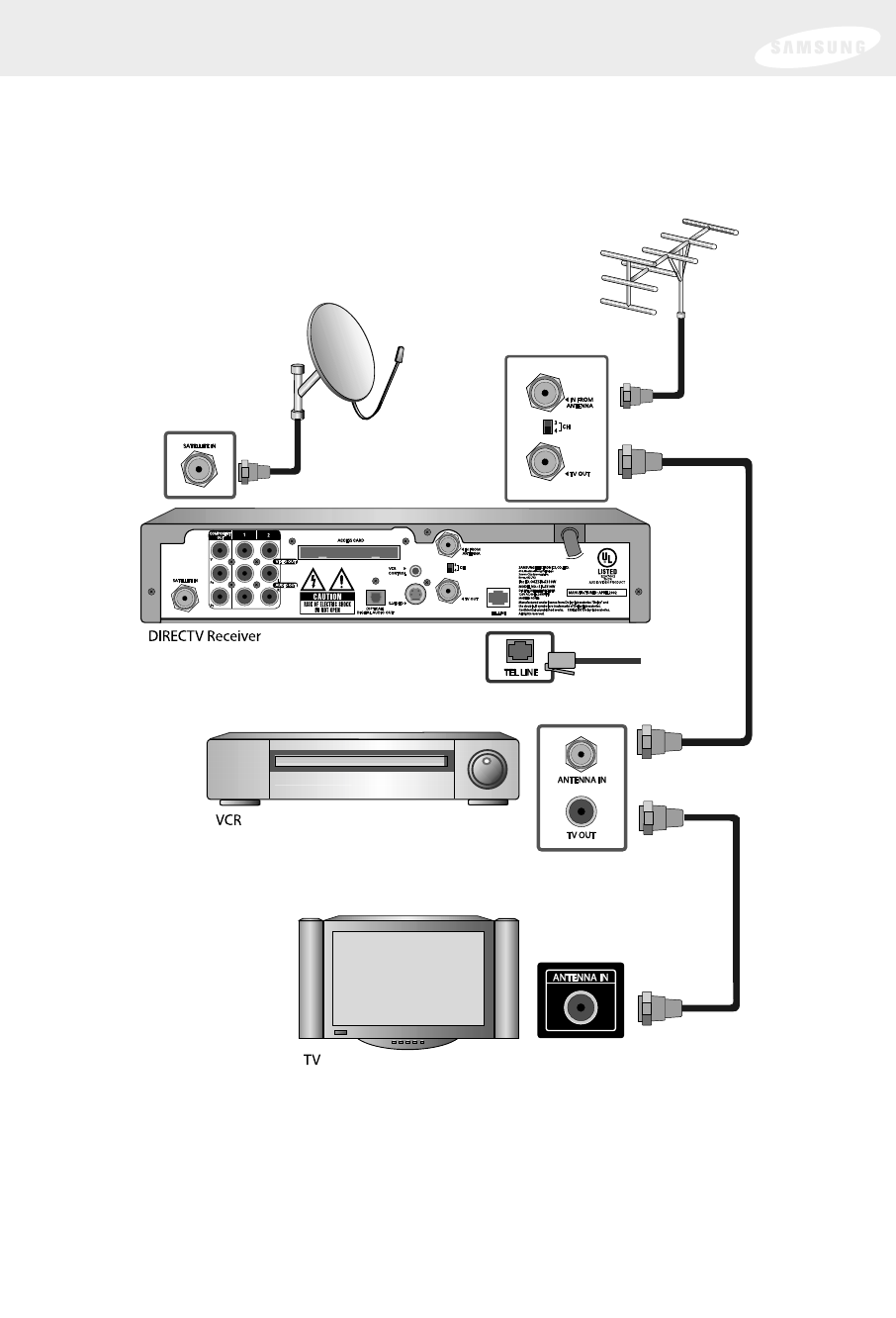
Chapter 2: Setting up and connecting
22
Note: DIRECTV Receiver model SIR-S310W shown;
connections are the same for model SIR-S300W.

Chapter 2: Setting up and connecting
23
Connection option D:
DIRECTV Receiver to TV and VCR with A/V cables
If connection option D best matches your needs,
follow these steps:
1
Make sure your TV, VCR, and DIRECTV Receiver are turned off and unplugged.
2Connect the RG-6 coaxial cable running from your satellite dish to the
SATELLITE IN jack on the back of your DIRECTV Receiver.
3Connect the coaxial cable running from your cable TV system or
off-air TV antenna to the IN FROM ANTENNA jack on the back of
the DIRECTV Receiver.
4Connect the supplied phone cord to a telephone wall jack and to the
TEL LINE jack on the back of the DIRECTV Receiver.
5Matching like colors, connect the supplied A/V cables to the AUDIO OUT and
VIDEO OUT jacks on the back of the DIRECTV Receiver.
6Connect the other ends of these A/V cables to the audio and video input jacks
on your VCR. Be sure to connect the A/V jacks on the DIRECTV Receiver to
corresponding inputs on your VCR (video out to video in, left audio out to left
audio in, right audio out to right audio in).
7Matching like colors, connect another set of A/V cables (not included) to the
other set of audio and video output jacks on the back of the DIRECTV
Receiver. Connect the other ends of these cables to the audio and video input
jacks on your TV. Be sure to connect the outputs on the DIRECTV Receiver to
corresponding inputs on your TV.
8(Optional) if your TV and VCR both have S-Video jacks, you can also make the
S-Video connections shown in the illustration. This step is optional; it provides
improved picture quality.
9(Optional, model SIR-S310W only) go to page 29 to hook up the VCR control.
10 Plug in the power cords for your TV, VCR, and DIRECTV Receiver.
To watch DIRECTV®programming
Set your TV to the appropriate input mode. (This is a setting on your TV usually
controlled by a Video, Input, or Mode button. See your TV manual for help.) Also
make sure your VCR is turned on.
Next Step
Now turn to page 29 to start using your DIRECTV Receiver.
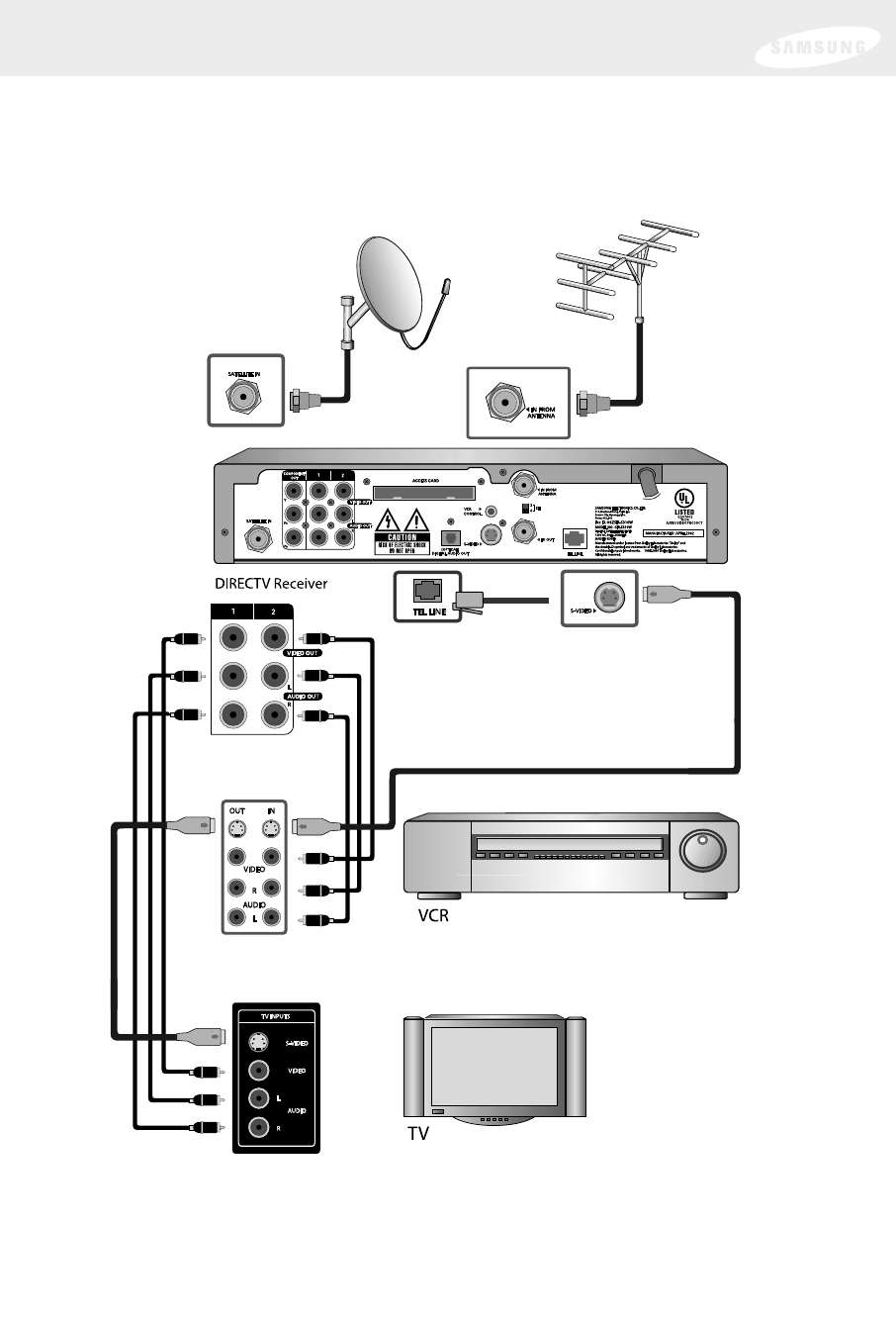
Chapter 2: Setting up and connecting
24
Note: DIRECTV
Receiver model
SIR-S310W shown;
connections are
the same for model
SIR-S300W.

Chapter 2: Setting up and connecting
25
Connection option E:
DIRECTV Receiver to TV and A/V receiver
If connection option E best matches your needs,
follow these steps:
1Make sure your TV, A/V receiver, and DIRECTV Receiver are turned off
and unplugged.
2Connect the RG-6 coaxial cable running from your satellite dish to the
SATELLITE IN jack on the back of your DIRECTV Receiver.
3Connect the coaxial cable running from your cable TV system or
off-air TV antenna to the IN FROM ANTENNA jack on the back of
the DIRECTV Receiver.
4Connect the supplied phone cord to a telephone wall jack and to the
TEL LINE jack on the back of the DIRECTV Receiver.
5Matching like colors, connect the supplied A/V cable to the AUDIO OUT and
VIDEO OUT jacks on the back of the DIRECTV Receiver.
6Connect the other ends of the A/V cables to appropriate audio and video input
jacks on your A/V receiver. Be sure to connect the outputs on the DIRECTV
Receiver to corresponding inputs on your A/V receiver (video out to video in,
left audio out to left audio in, right audio out to right audio in).
7Connect another set of A/V cables (not included) to the second set of audio
and video output jacks on the the back of the DIRECTV Receiver.
8Connect the other ends of these A/V cables to the appropriate audio and video
input jacks on your TV. Be sure to connect the outputs on the DIRECTV
Receiver to corresponding inputs on your TV.
9(Optional) if your TV and A/V receiver both have S-Video jacks, you can also
make the S-Video connections shown in the illustration. This step is optional; it
provides improved picture quality.
10 Plug in the power cords for your TV, A/V receiver, and DIRECTV Receiver.
To watch DIRECTV®programming
Set your A/V receiver and TV to the appropriate input mode. See the manuals for
your A/V receiver and TV for instructions.)
Next Step
Now turn to page 29 to start using your DIRECTV Receiver.
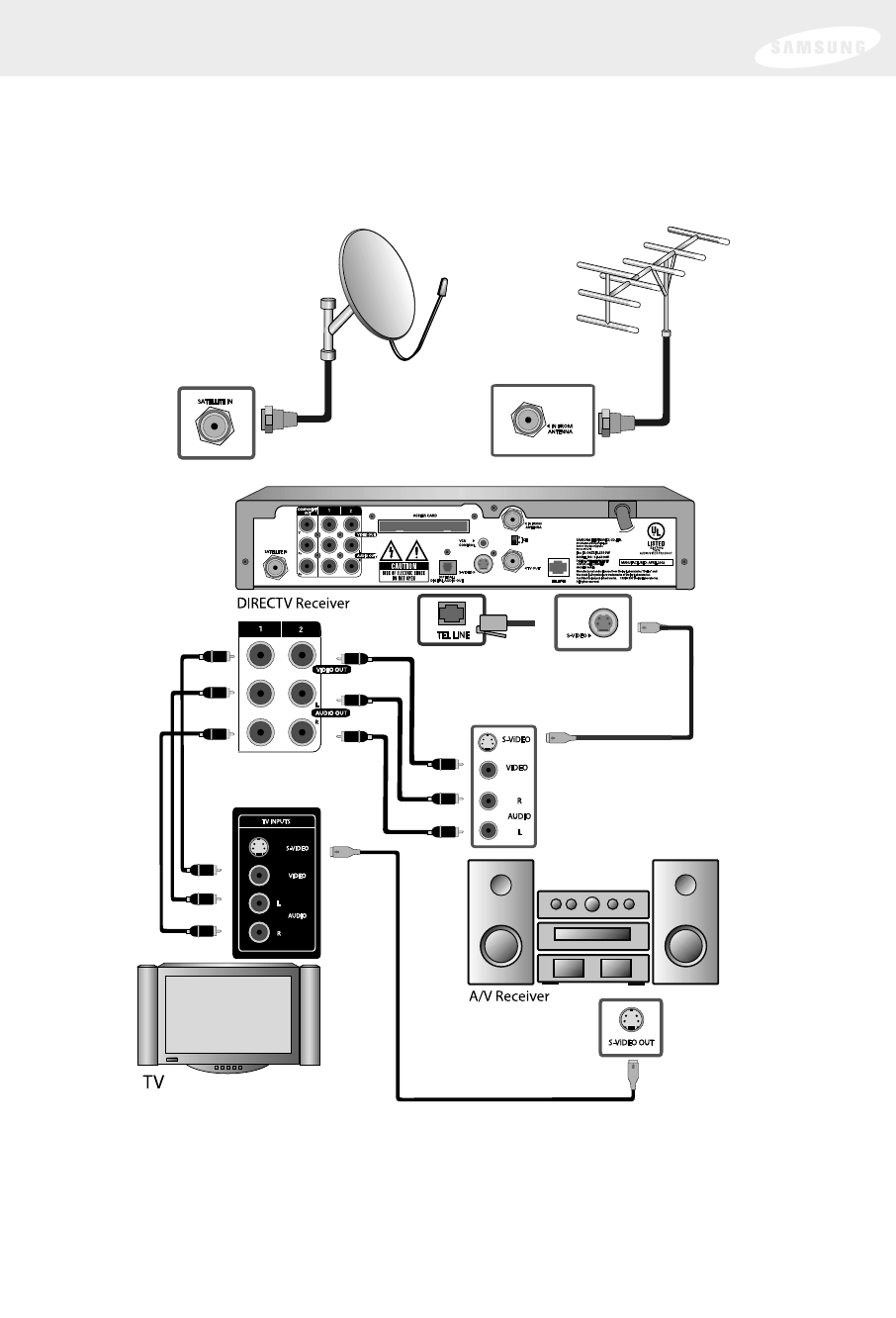
Chapter 2: Setting up and connecting
26
Note: DIRECTV Receiver model SIR-S310W shown;
connections are the same for model SIR-S300W.

Chapter 2: Setting up and connecting
27
Connection option F (SIR-S310W only):
DIRECTV Receiver to TV with Component Video inputs
and digital A/V receiver
1Make sure your TV, A/V receiver, and DIRECTV Receiver are turned off
and unplugged.
2Connect the RG-6 coaxial cable running from your satellite dish to the
SATELLITE IN jack on the back of your DIRECTV Receiver.
3Connect the coaxial cable running from your cable TV system or
off-air TV antenna to the IN FROM ANTENNA jack on the back of
the DIRECTV Receiver.
4Connect the supplied phone cord to a telephone wall jack and to the
TEL LINE jack on the back of the DIRECTV Receiver.
5Connect one end of a set of three component video cables (not included) to
the COMPONENT OUT jacks on the back of the DIRECTV Receiver.
6Connect the other ends of these cables to the component video input
jacks on your TV. Be sure to connect the outputs on the DIRECTV Receiver to
corresponding inputs on your TV (Y out to Y in, Pb out to Pb in,
Pr out to Pr in).
7Connect one end of the supplied A/V cable’s audio connectors (the red and
white connectors) to the AUDIO OUT jacks on the back of the DIRECTV
Receiver. (You can leave the yellow video connector on this cable
disconnected.)
8Connect the other ends of the audio cables to the audio input jacks on your TV
(again leaving the yellow video connector disconnected).
9Remove the protective plug from the OPTICAL DIGITAL AUDIO OUT jack.
Then connect an optical digital audio cable (not included) to the OPTICAL
DIGITAL AUDIO OUT jack on the back of the DIRECTV Receiver.
10 Connect the other end of this cable to an appropriate optical digital audio In
jack on your A/V receiver.
11 Plug in the power cords for your TV, A/V receiver, and DIRECTV Receiver.
To watch DIRECTV®programming
Set your TV to the Component Video input mode. (This is a setting on your TV usually
controlled by a Video, Input, or Mode button. See your TV manual for help.) Also set
your A/V receiver to play the audio from the Digital Input jack you used to make the
audio connection. See your A/V receiver manual for help.
Next Step
Now turn to page 29 to start using your DIRECTV Receiver.
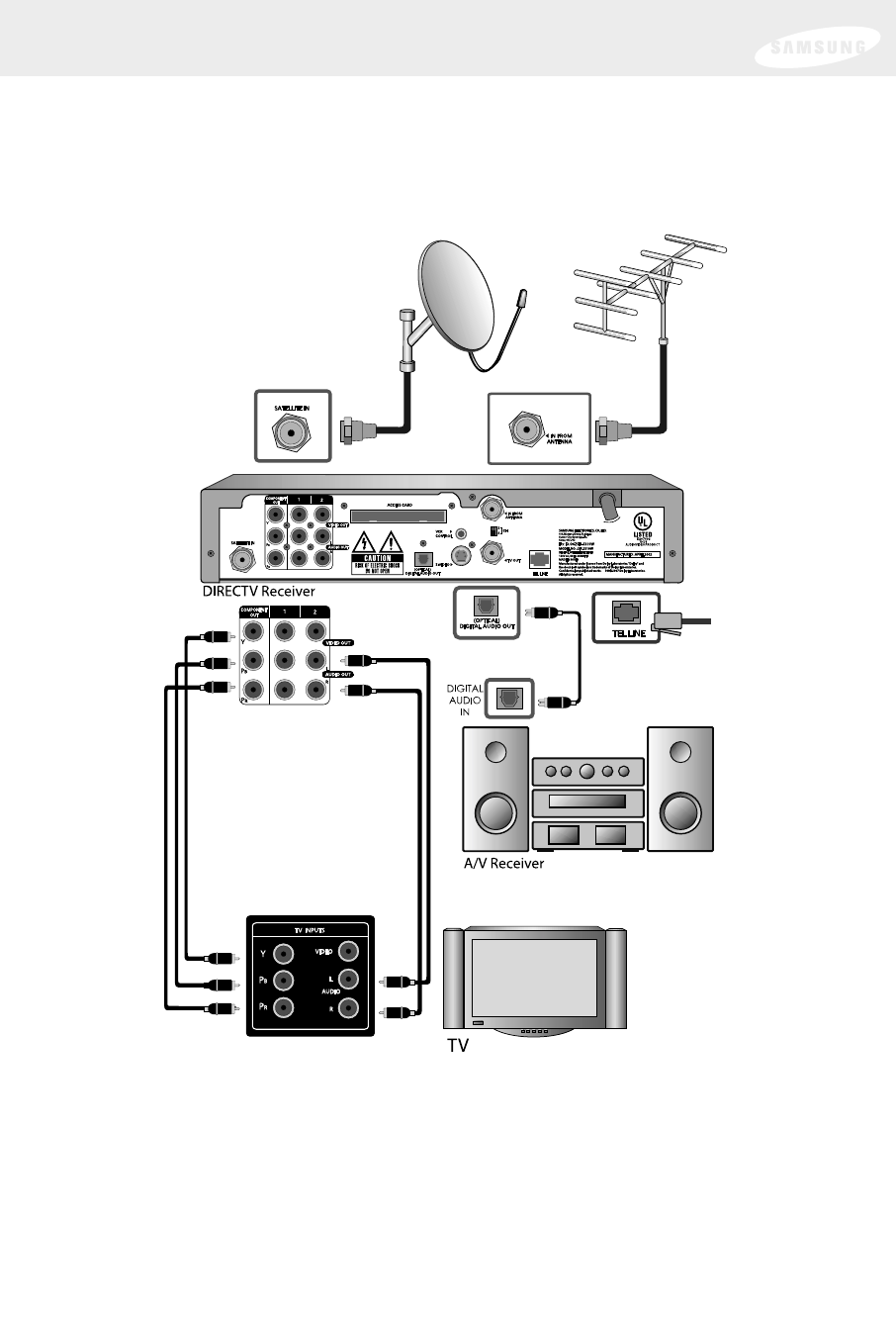
Chapter 2: Setting up and connecting
28
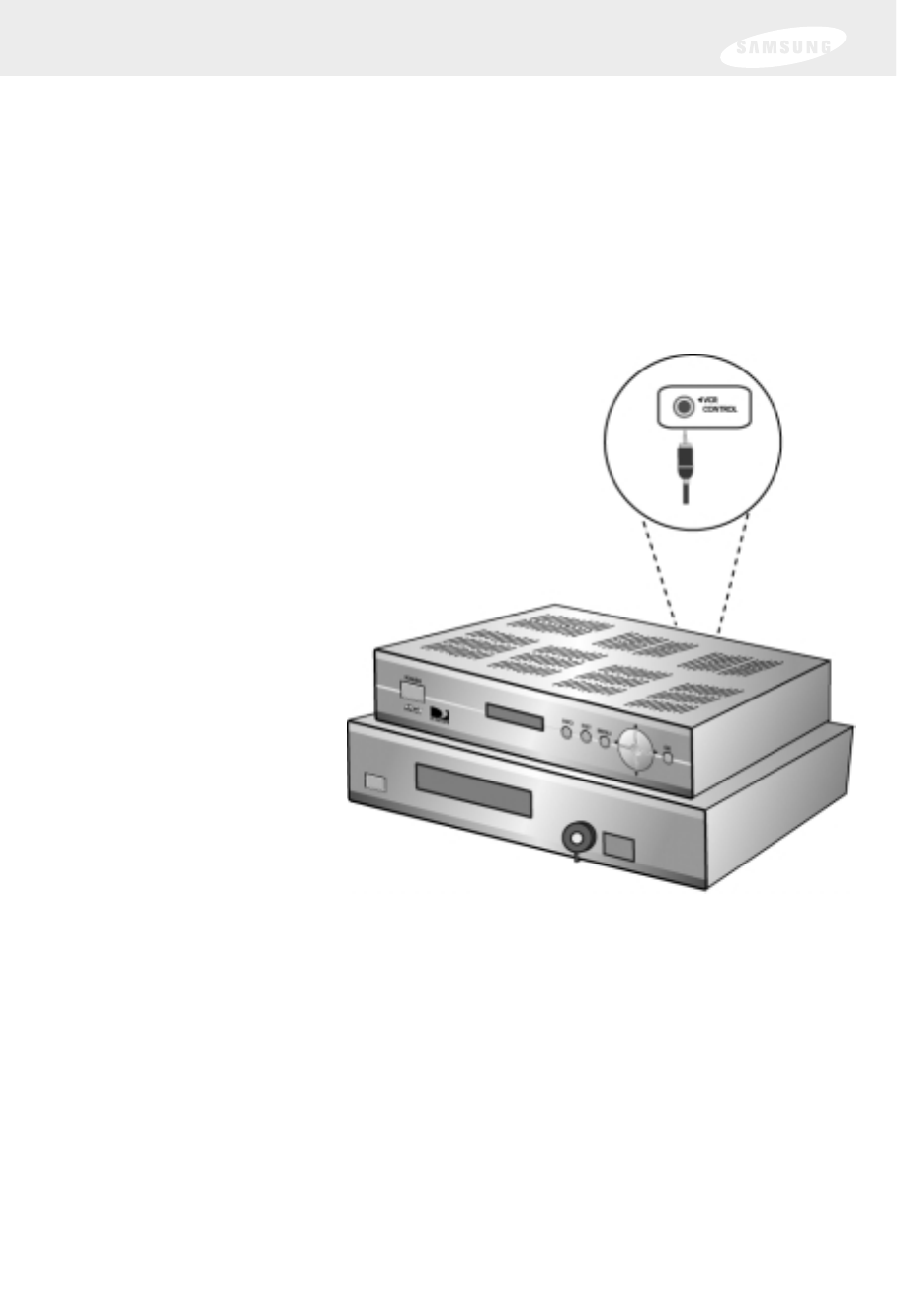
Chapter 2: Setting up and connecting
29
Connecting the VCR control cable
(model SIR-S310W only)
The VCR control cable allows your model SIR-S310W DIRECTV Receiver to
automatically program your VCR to record a TV program. By selecting a Record
option from the on-screen Program Guide, you can direct the VCR control cable to
flash signals to the VCR’s remote control sensor programming the VCR to tape a TV
program for you.
To connect the VCR control cable to your model SIR-S310W DIRECTV Receiver,
follow these steps:
1Plug the VCR control cable into the VCR CONTROL
jack on the back of the DIRECTV Receiver.
2Remove the backing tape from the adhesive on the
other end of the VCR control cable. Stick the VCR
control onto the remote control sensor on your
VCR. (See the manual for your VCR if you are not
sure where its remote sensor is located.).
Note: Before you can use the VCR control cable to program your VCR, you must
set up the VCR control. See Setting up the VCR control in Chapter 4 for details.
Turning on the DIRECTV Receiver for the first time
You have completed the setup steps and are ready to start using your
DIRECTV Receiver. The first step is to turn on the DIRECTV Receiver.
1Turn on your TV and set it to display the signal from your DIRECTV Receiver.
DIRECTV
Receiver
VCR
VCR control

If you connected the DIRECTV Receiver to an RF-type input jack, you will need
to tune your TV to channel 3 or 4 (depending on how the CH 3/4 switch on
the back of the DIRECTV Receiver is set). If you have a VCR, the VCR must be
in TV mode or turned off.
If you connected the DIRECTV Receiver to A/V input jacks on your TV, you will
need to set your TV to display the input from these jacks. Usually this is done
by pressing a Video, Input, or Mode button on your TV’s remote control. (See
the manual for your TV if you need help.)
2Press the POWER button on the DIRECTV Receiver’s remote control or on the
front of the DIRECTV Receiver.
The light on the front panel will turn on.
If this is the first time you have
turned on your DIRECTV Receiver, it
will take a few moments to acquire
the program guide from the
satellite. During this process, the
Progress screen appears.
When the program guide has been
fully acquired, the Progress screen
clears and the TV screen is
displayed. You are ready to continue
setting up your DIRECTV System.
Adjusting the satellite dish
If your DIRECTV Receiver is able to acquire the program guide and display TV
programs, your satellite dish is setup and working. You can skip ahead to the section
on Activating your DIRECTV account at the end of this chapter.
If your DIRECTV Receiver cannot acquire the program guide, you may need to
adjust the way your satellite dish is installed. To do this, first make sure your TV and
DIRECTV Receiver are turned on and connected to each other properly. Then follow
the instructions below to use your DIRECTV Receiver’s Menu system to set up your
satellite dish.
The Installation option in the SETUP menu provides access to a variety of important
setup controls. The first of these is the Set Dish menu. The Set Dish menu allows
you to:
•Acquire the exact azimuth, elevation, and tilt angles to help you point your dish
accurately based on your ZIP code.
•Check the setup of your satellite dish using an on-screen signal meter.
•Set the dish type (to tell your DIRECTV Receiver what kind of satellite dish you
are using).
•Set your dish type automatically.
The sections that follow detail each of these procedures.
Chapter 2: Setting up and connecting
30
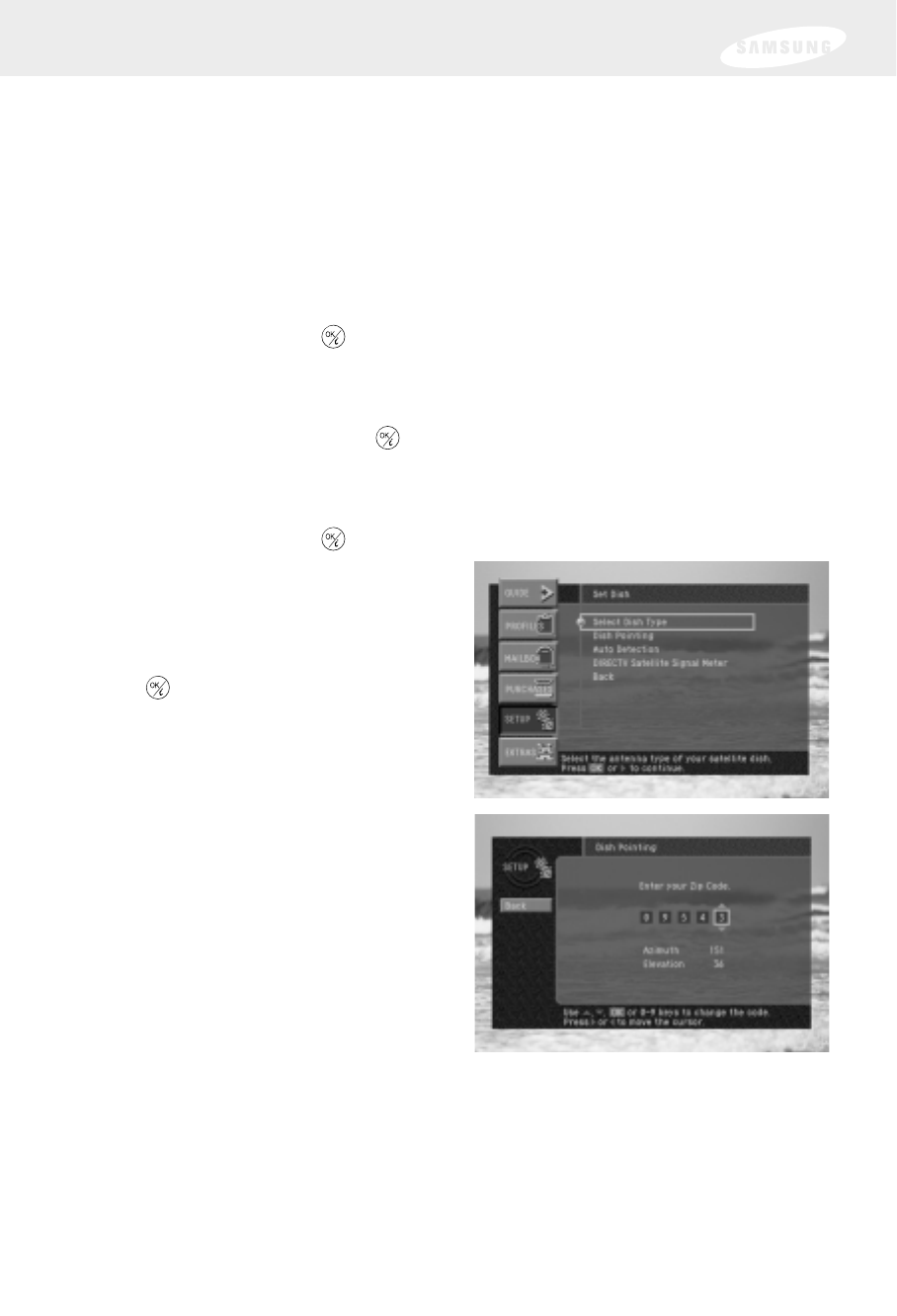
Chapter 2: Setting up and connecting
31
Acquiring the correct dish pointing angles
The Dish Pointing menu item in the Set Dish menu allows you to find out exactly
how to point your satellite dish by entering your ZIP code. If you have not yet
successfully aligned your satellite dish, or if you need to realign it, follow these
instructions to find the exact angles you should use to point your dish:
1Press the MENU button on your remote control.
The Main menu appears.
2Use the arrow buttons on your remote control to highlight the SETUP menu
item, then press the button on your remote control.
The SETUP menu appears.
3Use the arrow buttons on your remote control to highlight the Installation
menu item, then press the button on your remote control.
The Installation menu appears.
4Use the arrow buttons on your remote control to highlight the Set Dish menu
item, then press the button on your remote control.
The Set Dish menu appears.
5Use the arrow buttons on your
remote control to highlight the Dish
Pointing menu item, then press the
button on your remote control.
The Dish Pointing screen appears.
6Use the right-arrow button on your
remote control to highlight the space
for the first digit in the ZIP code.
7Use the 0 - 9 buttons on your
remote control to enter your five-
digit ZIP code.
As you enter each number, the
highlight advances to the next
space.
When you have entered all five digits, the screen updates to display the correct
azimuth, elevation, and (for oval dish types only) tilt.
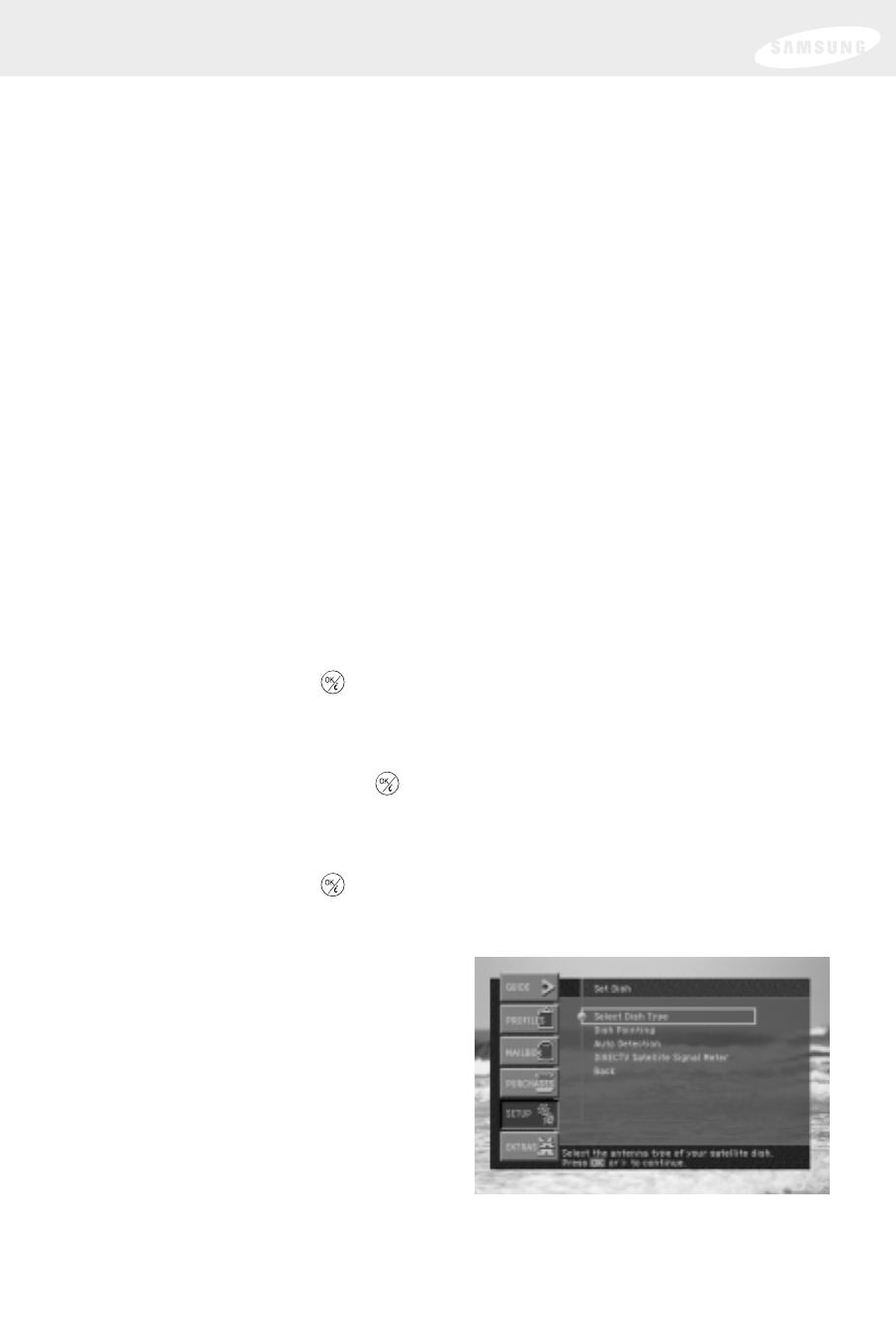
Chapter 2: Setting up and connecting
32
Azimuth refers to the left-to-right angle to which you should point your dish.
Elevation refers to the up-and-down angle to which you should point
your dish.
Tilt (for oval dishes only) refers to the amount off-horizontal you should twist
the dish on its axis.
Write down these numbers and use them to accurately point your satellite dish.
8To return to the Set Dish menu, press the BACK button on your remote control.
To exit the Menu system, press the EXIT button on your remote control.
Checking the satellite signal strength
The Signal Meter allows you to check the strength of the signal from the satellite to
your satellite dish. This is useful while setting up your satellite dish, and while
troubleshooting any reception problems you may encounter. Satellite signal strength
can be affected by how accurately you have pointed the satellite dish, and by any
obstructions between the satellite and the satellite dish (tree limbs, for example).
To check your satellite signal strength, follow these steps:
1Press the MENU button on your remote control.
The Main menu appears.
2Use the arrow buttons on your remote control to highlight the SETUP menu
item, then press the button on your remote control.
The SETUP menu appears.
3Use the arrow buttons on your remote control to highlight the Installation
menu item, then press the button on your remote control.
The Installation menu appears.
4Use the arrow buttons on your remote control to highlight the Set Dish menu
item, then press the button on your remote control.
The Set Dish menu appears.
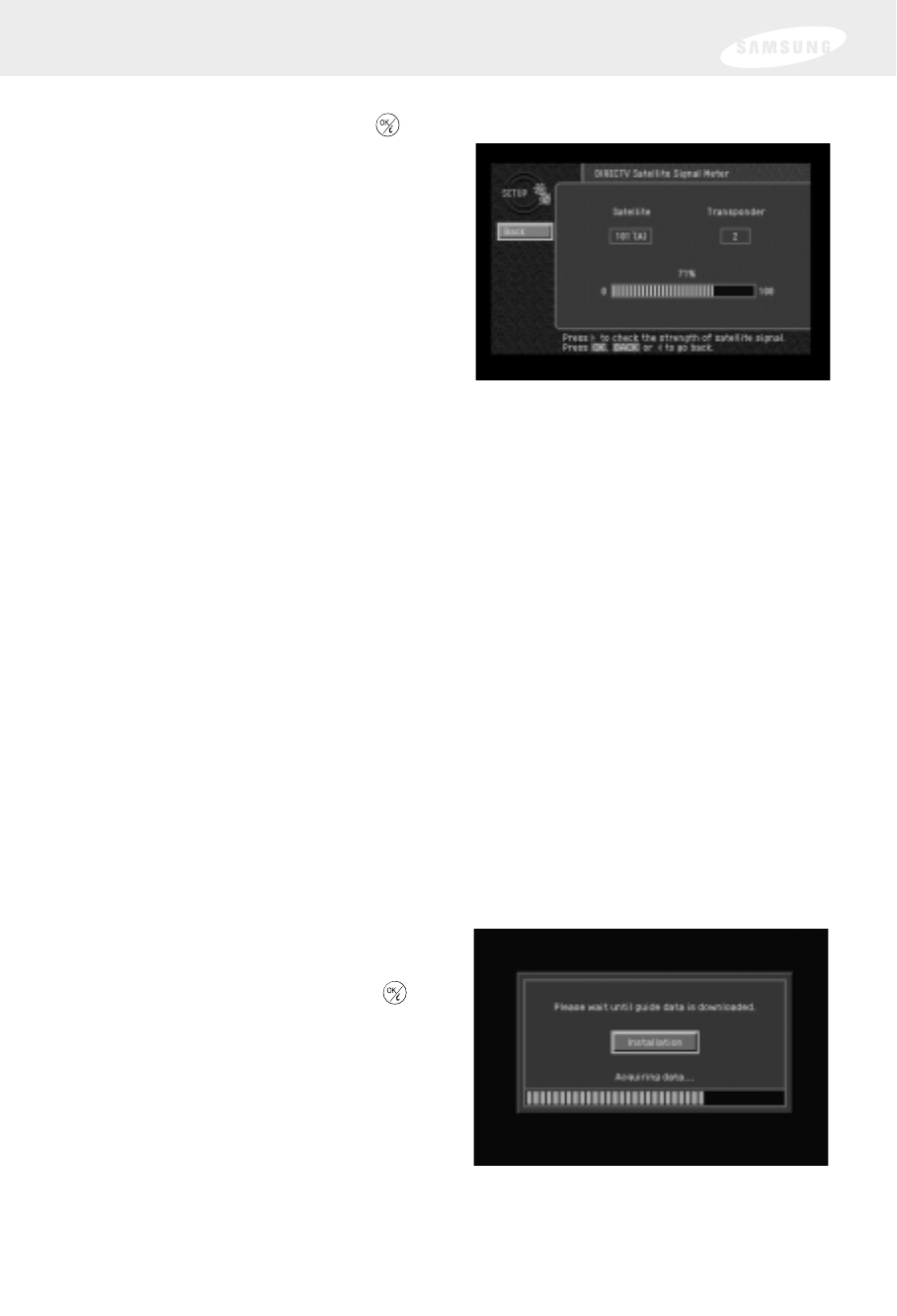
Chapter 2: Setting up and connecting
33
5Use the arrow buttons on your remote control to highlight the Signal Meter
menu item, then press the button on your remote control.
The Signal Meter screen appears.
The signal meter starts checking the
satellite signal strength immediately.
The signal strength (from 0-to-
100%) is indicated at the bottom of
the screen.
The Signal Meter screen allows you to check signal strengths from different
Satellites, and different Transponders. The Satellites option applies only to
oval-shaped satellite dishes which receive signals from multiple satellites. On
round dishes, the Satellite setting is fixed.
Transponders are the equipment on satellites that receive the signal from the
earth-based program providers and relay it back to earth to your satellite dish.
Different transponders handle the signals for different TV channels. When
setting up your satellite dish, you should try to maximize the signal strength
across all of the satellites and transponders.
6To check the signal strength for different satellites (oval dishes only), or
different transponders, use the left- and right-arrow buttons on your remote
control to highlight the on-screen Satellite or Transponder option, then use the
up- and down-arrow buttons to change the setting.
The signal meter updates to show you the signal strength for the new satellite
or transponder.
Setting the dish type
To function properly, your DIRECTV Receiver needs to know what type of satellite
dish you are using. You can specify the dish type using the instructions here, or you
can follow the steps on page 35 to use the Auto Detection menu item to
automatically set the dish type. To manually set the dish type:
1If the Progress screen (shown here)
is on your TV screen, select
Installation by pressing the
button on your remote control.
If this screen is not displayed, access the Main Menu by pressing the MENU
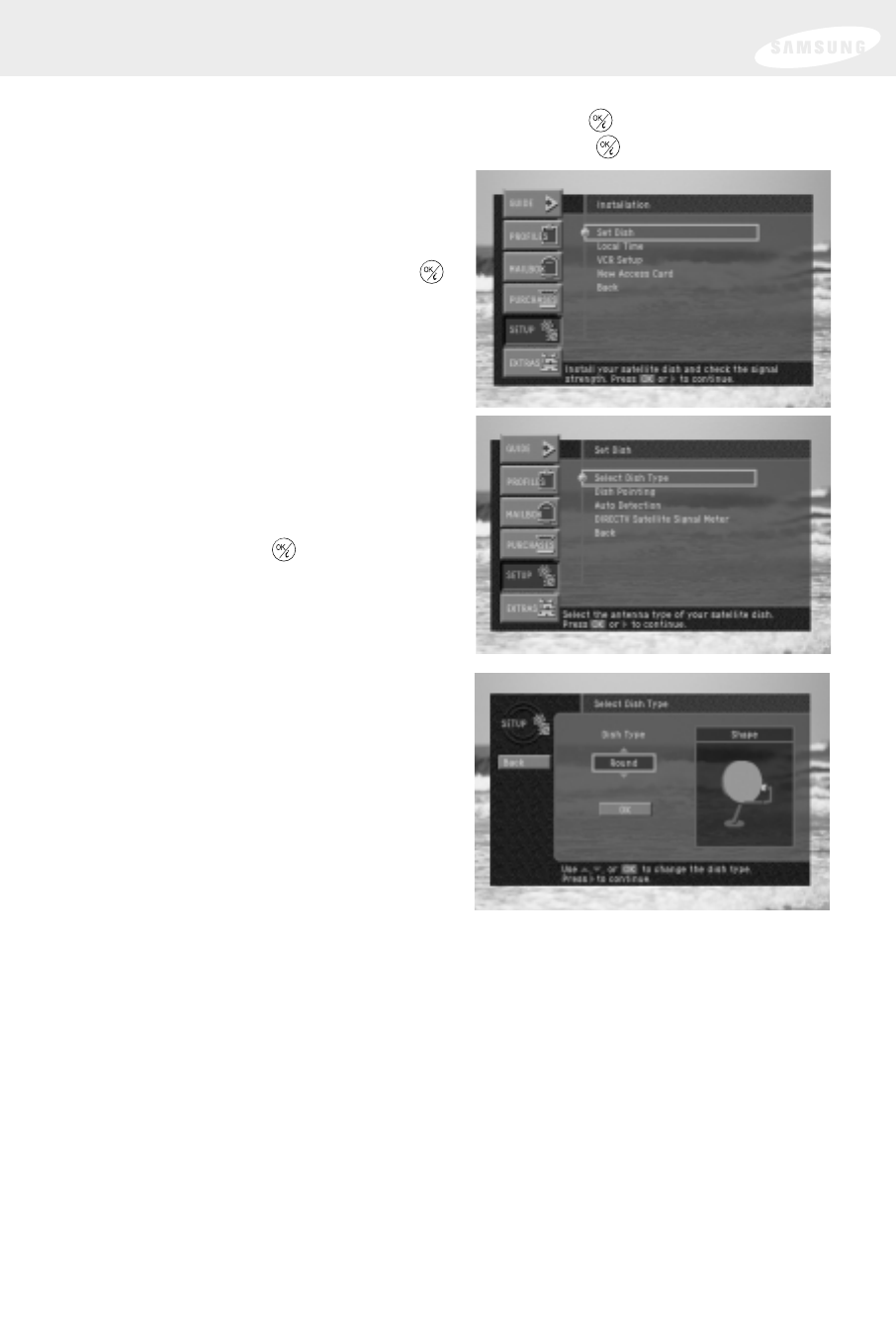
Chapter 2: Setting up and connecting
34
button on your remote control. Then use the arrow buttons on your remote
control to highlight the Setup menu, and press the button.
Then highlight the Installation menu, and press the button.
The Installation menu appears.
2Use the arrow buttons on your
remote control to highlight the Set
Dish menu item, then press the
button on your remote control.
The Set Dish menu appears.
3Use the arrow buttons on your
remote control to highlight the
Select Dish Type menu item,
then press the button on your
remote control.
The Select Dish Type screen appears.
4Use the right-arrow button on your
remote control to highlight the
Dish Type option on the Select Dish
Type screen.
5Use the up- and down-arrow
buttons on your remote control to
display the dish type you are using
(Round, Oval-2, or Oval-3).
As you display each dish type, the on-screen pictures update showing you what
each of these dish types look like.

Chapter 2: Setting up and connecting
35
6When you have displayed the correct dish type, use the right-arrow button on
your remote control to highlight the on-screen OK button, then press
the button on your remote control.
A message appears warning you that
your DIRECTV Receiver needs to
reboot (turn itself off and on) for the
Dish Type setting to take effect.
7To change the Dish Type to the new
setting, use the arrow buttons on
your remote control to highlight the
on-screen OK button, then press the
button on your remote control.
To leave the Dish Type setting
unchanged, highlight the on-screen Cancel button, and press the button on
your remote control.
Using Auto Detection to set the dish type
To function properly, your DIRECTV Receiver needs to know what type of satellite
dish you are using. You can specify the dish type using the instructions on page 33,
or you can follow the steps below to use the Auto Detection menu item to
automatically set the dish type.
Before you can use Auto Detection to set the dish-type, the dish must be correctly
aligned and the DIRECTV Receiver must be receiving a strong signal from the
satellite (that is, signal-lock must be established). To check the satellite signal, use
the signal meter — see page 32 for details.)
1Press the MENU button on your remote control.
The Main menu appears.
2Use the arrow buttons on your remote control to highlight the SETUP menu
item, then press the button on your remote control.
The SETUP menu appears.
3Use the arrow buttons on your remote control to highlight the Installation
menu item, then press the button on your remote control.
The Installation menu appears.
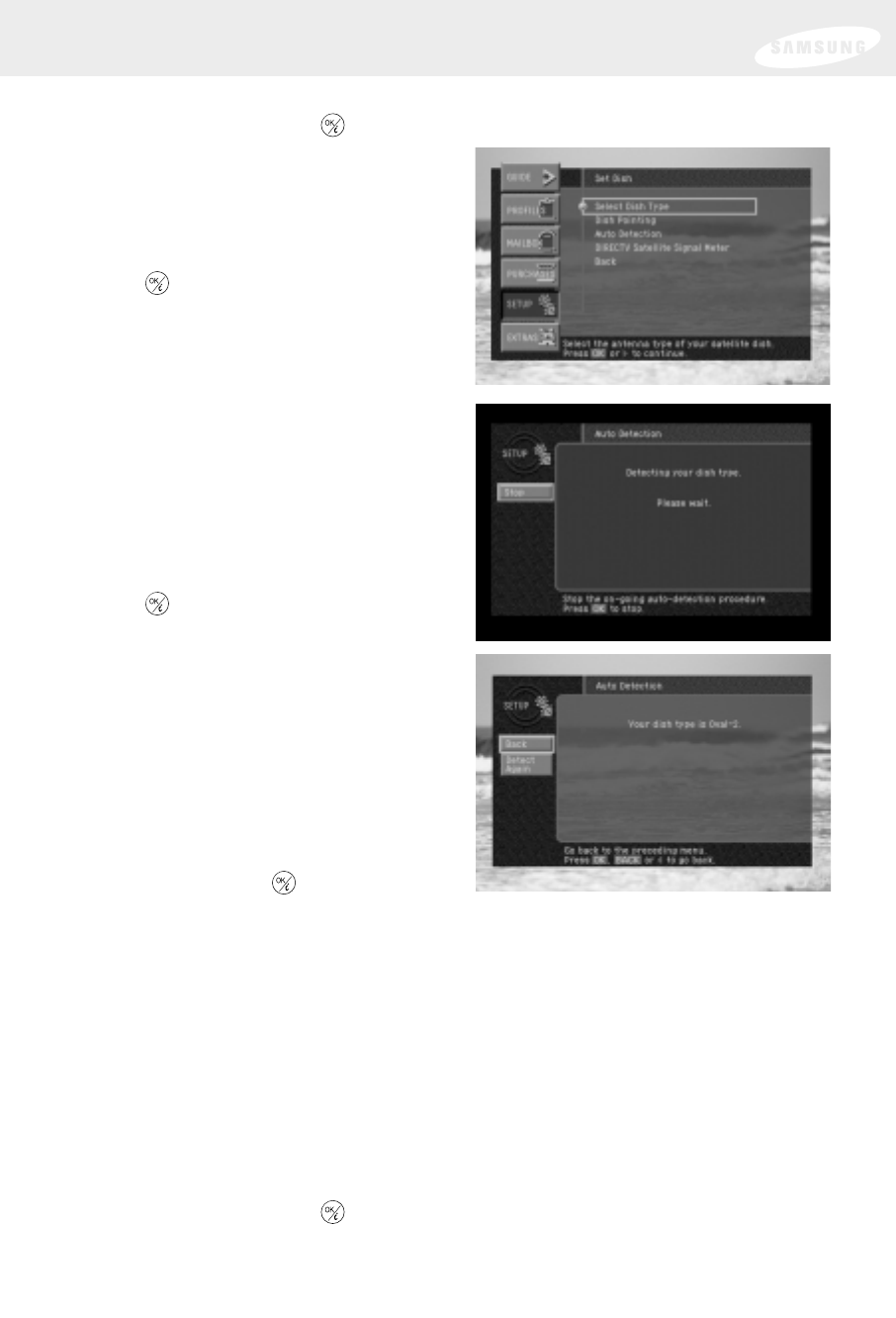
Chapter 2: Setting up and connecting
36
4Use the arrow buttons on your remote control to highlight the Set Dish menu
item, then press the button on your remote control.
The Set Dish menu appears.
5Use the arrow buttons on your
remote control to highlight the Auto
Detection menu item, then press the
button on your remote control.
The Auto Detection screen appears.
The DIRECTV Receiver starts
attempting to identify the dish type.
You can stop the detection process
by using the arrow buttons on your
remote control to highlight the on-
screen Cancel button, then press the
button on your remote control.
Once the dish type has been
identified, a screen appears telling
you what type of satellite dish you
have.
6To accept the detected dish type
setting, use the arrow buttons on
your remote control to highlight
the on-screen Back button,
then press the button on your
remote control.
Testing the DIRECTV Receiver
The System Test feature allows you to quickly check the status of the satellite signal,
your Access Card, and your phone line connection. This is helpful in troubleshooting
should you experience problems with your DIRECTV Receiver.
To start the System Test, follow these steps:
1Press the MENU button on your remote control.
The Main menu appears.
2Use the arrow buttons on your remote control to highlight the SETUP menu
item, then press the button on your remote control.
The SETUP menu appears.
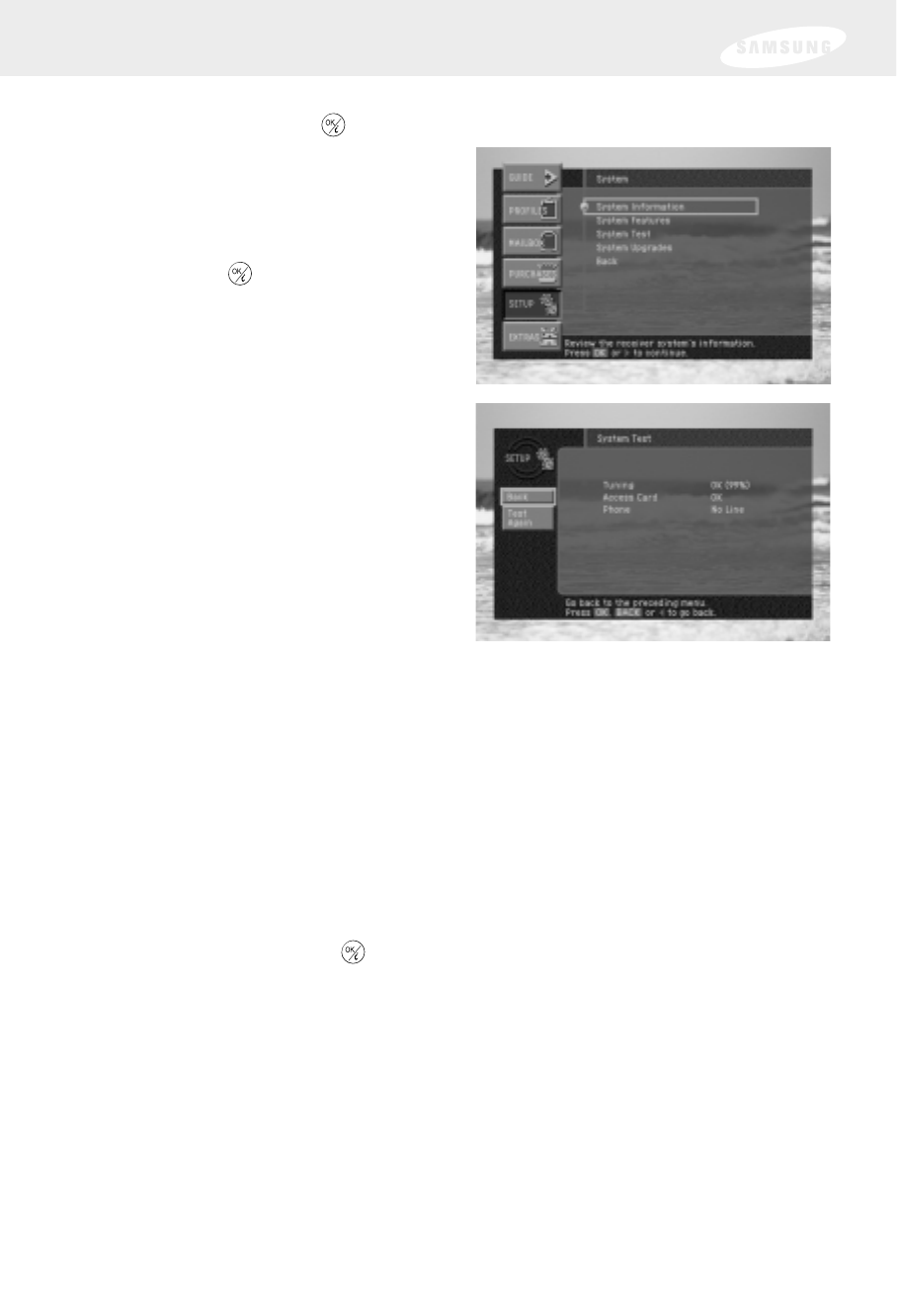
Chapter 2: Setting up and connecting
37
3Use the arrow buttons on your remote control to highlight the System menu
item, then press the button on your remote control.
The System menu appears.
4Use the arrow buttons on your
remote control to highlight the
System Test menu item, then
press the button on your
remote control.
The System Test screen appears.
The test will begin as soon as the
screen appears. Results are displayed
in a moment.
If the test discovers a problem with
the satellite tuning, check that the
satellite dish is pointed properly, and
that nothing is obstructing the direct
view to the satellite (over time trees
can grow enough to block a
previously open view).
If the test discovers a problem with the Access Card, check that the card is
properly inserted. (See Inserting the Access Card in Chapter 1 for details.)
For problems with the phone line connection, be sure that the DIRECTV
Receiver is connected to a phone line, and that the phone line is working. (Try
plugging a telephone into the line you are using for the DIRECTV Receiver;
check to see if the phone gets a dial tone. If so, the line is working.)
5When you have finished the system test, you can run the test again using the
on-screen Test Again button, exit the Menu system by pressing the EXIT button
on your remote control, or use the arrow keys to highlight on-screen Back
button, then press the button to return to the System menu.

Chapter 2: Setting up and connecting
38
Activating your DIRECTV account
After you have installed and connected the the satellite dish and DIRECTV Receiver,
you must contact your service provider to create an account. To order programming
from DIRECTV, please call 1-800-DIRECTV (1-800-347-3288).
With this Digital Satellite Receiver and the proper Satellite Dish Antenna, you may
be able to receive local channels from DIRECTV in certain markets. Additional
equipment may be required in some areas. Check with your retailer or visit
www.DIRECTV.com for information on availability of local channels from DIRECTV
in your area.
ACTIVATION OF PROGRAMMING MAY BE SUBJECT TO CREDIT APPROVAL AND
REQUIRES VALID SERVICE ADDRESS, SOCIAL SECURITY NUMBER AND/OR
MAJOR CREDIT CARD. DEPOSIT OR PREPAYMENT MAYBE REQUIRED.
Programming subject to change. Rec of DIRECTV Programming is subject to terms
of the DIRECTV customer agreement; a copy is provided at DIRECTV.com and in
your first bill. You must be physically located in the U.S. to receive DIRECTV®
service. DIRECTV®services not available outside the U.S. DIRECTV®programming
is sold separately and independently of DIRECTV System hardware. A valid
programming subscription is required to operate DIRECTV System hardware.
Upgrades
Your digital satellite receiver is able to receive upgrades or modifications to some of
its features and functions. These modifications will occur automatically, usually at
times when the receiver would likely be turned off.
If your receiver is on when an upgrade or modification is sent, you may experience a
disruption in reception for a minute or two. Your reception should return to normal
after the modification is complete. Your receiver must be plugged in to receive any
upgrades. Do not unplug your receiver while an upgrade is in progress. Please
consult the System Upgrades menu item (in the System section of the Setup menu)
to find a schedule of upgrades or modifications planned by DIRECTV.
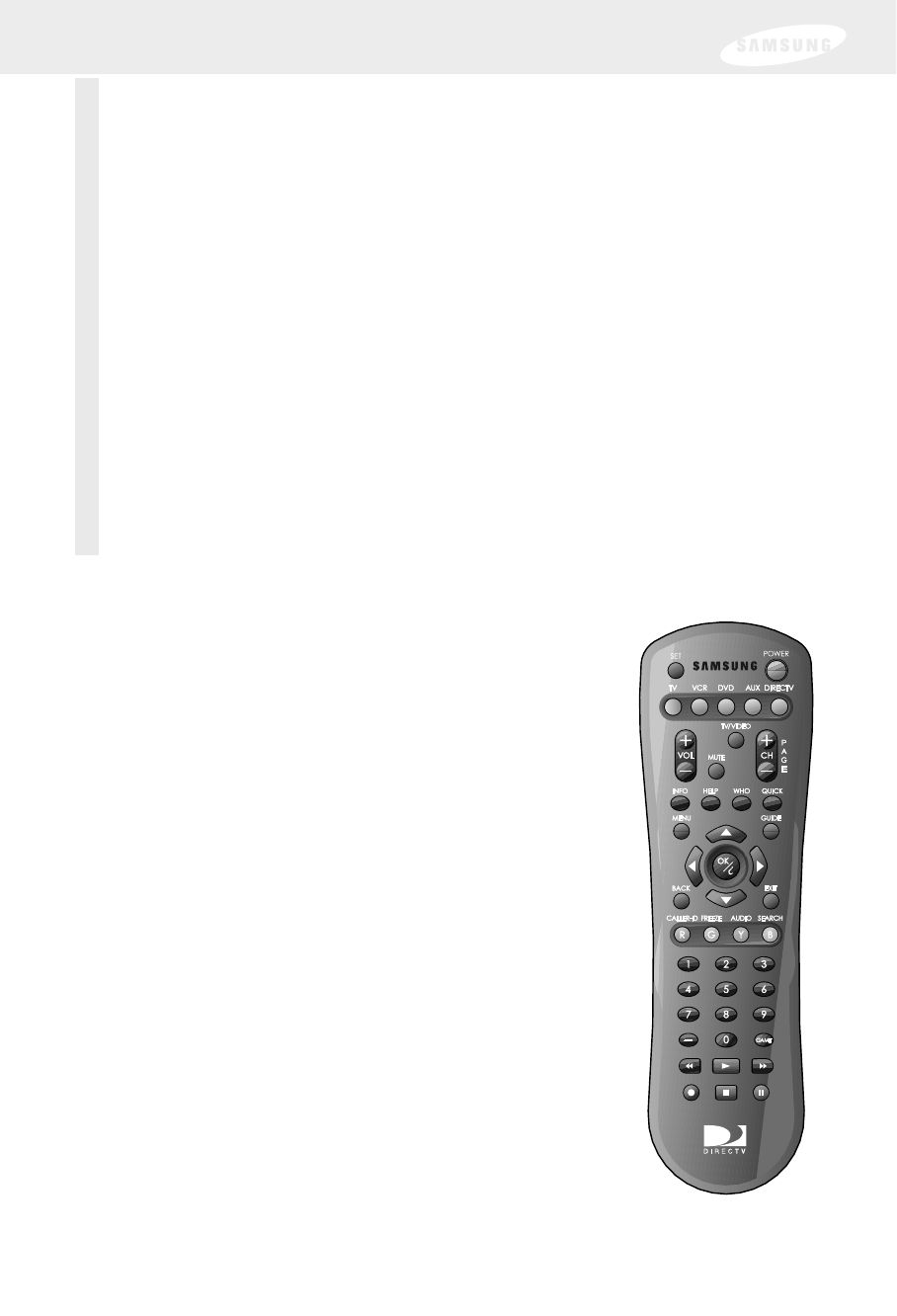
Remote control overview
Here is a quick review of the buttons on your DIRECTV
Receiver’s remote control.
Before your DIRECTV Receiver’s remote control can operate
your TV, VCR, DVD player, or other device, you must first
program the remote control to operate that device.
See Chapter 7: Programming the remote control.
POWER
Press the POWER button to turn the device you are
controlling on or off.
SET
Use this button when programming your remote control to
operate your TV, VCR, DVD player, or an auxiliary device
(AUX). See Chapter 7, Programming the remote control.
TV, VCR, DVD, AUX
This row of buttons tells your remote control which device
you want to operate. For example, to start playing a DVD,
you would press the DVD button, then press the Play
button. These buttons work only after the remote control
has been programmed — see Chapter 7.
DIRECTV
Press this button to make the remote control operate your
DIRECTV Receiver (e.g. to change channels, access the
Guide, or get information about a program). Your remote
control does not need to be programmed to operate your
DIRECTV Receiver.
39
Chapter 3: Watching TV
This chapter covers all of the things you can do with the Program Guides and other
features that let you control the way you watch TV. Specifically, it contains
information on:
•Remote control overview
•Changing channels
•Adjusting the volume
•Getting help
•Getting information on the TV program you are watching
•Finding out what’s on: the Guides
•Searching for programs in the Guide
•Choosing an alternate audio format for a program
•Changing the User setting
•Pay per view programs

40
VOL+/-
Press these buttons to adjust the volume
level of your TV (once the remote control
has been programmed — see Chapter 7).
You can control the volume of your TV
when in TV, DIRECTV, or VCR mode.
MUTE
Press this button to mute or unmute the TV
audio (once the remote control has been
programmed — see Chapter 7).
TV/VIDEO
Press this button to switch the TV between
its video input modes (once the remote
control has been programmed — see
Chapter 7).
CH+/-
Press these buttons to change channels on
your DIRECTV Receiver or on your TV (once
the remote control has been programmed —
see Chapter 7).
INFO
Press this button when you are watching
DIRECTV®programming to display the
Channel Banner and information about the
current program.
HELP
Displays instructions about the screen or
menu currently displayed.
WHO
Press to change the current user profile.
QUICK
Press this button to view the Quick Guide.
MENU
Press this button to display the on-screen Menu.
GUIDE
Press to view the on-screen Program Guide.
Press this button to select highlighted items
in the on-screen Menu or Guide. This button
also accesses DIRECTV INTERACTIVETM
program enhancements when you see the i
icon appears on your TV screen.
Up/Down/Left/Right arrows
Use these buttons to move the highlight to
any on-screen Guide or Menu selection.
BACK
Press this button to return to the previous
channel you were watching, or to return to a
previous Menu screen.
EXIT
Press this button to exit any Guide or Menu
screen and return to the TV program you
were watching.
CALLER ID (red button)
Displays the phone numbers of callers who
phoned you on the telephone line connected
to your DIRECTV Receiver (works only if you
subscribe to your local telephone service’s
caller ID service). While in the Guide, this
button lets you change the Guide style.
FREEZE (green button)
Press this button to take a still picture of the
TV screen. Press it again to resume the
program you were watching. While in the
Guide, this button lets you see program
listings for a different time.
AUDIO (yellow button)
While watching TV, press this button to
select an alternate audio track. While in the
Guide, this button lets you view programs in
selected categories.
SEARCH (blue button)
Press this button to search for a program
listing in the Guide.
Number and dash buttons (0-9, – )
Press the number buttons to tune directly to
a particular channel or to enter numerical
values in the Menu system. Press the dash
button (–) to enter a separator between
parts of a number.
GAME
Accesses games you can play.
VCR control buttons
Operate your VCR with the Play, Rewind,
Fast-Forward, Record, Stop and Pause
buttons at the bottom of the remote control
(once the remote control has been
programmed — see Chapter 7).
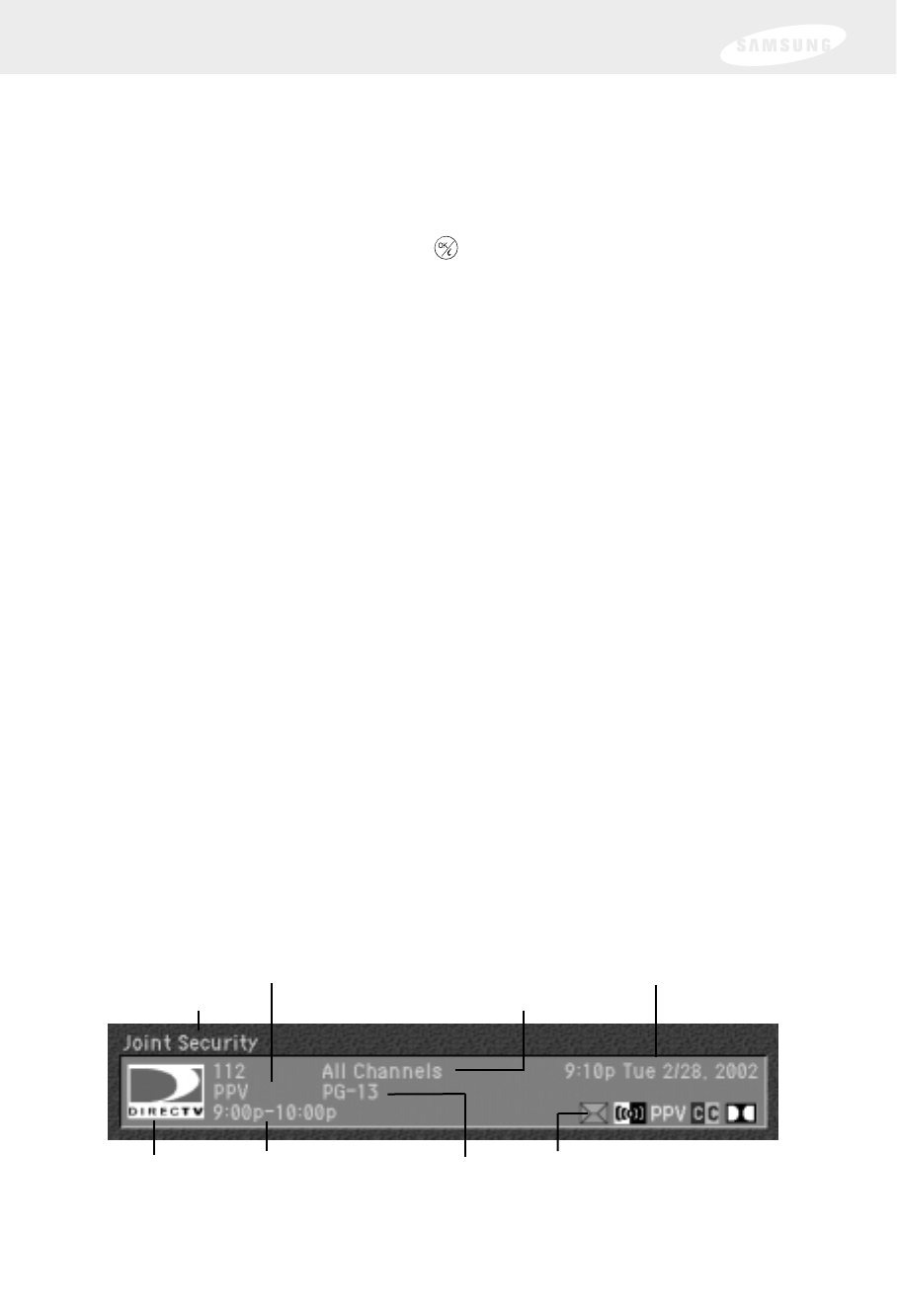
41
Chapter 3: Watching TV
Changing channels
There are several ways to change the channel you are watching:
1Press the CH + button on the remote control to tune to a higher channel number.
Press the CH - button to tune to a lower channel number.
2Enter a channel number directly with the 0 - 9 number buttons.
After entering a number, press the button or wait a few seconds for the
system to tune to the new channel.
3Use the Quick Guide or full-screen Program Guide to change channels.
Adjusting the volume
To adjust the volume while watching DIRECTV® programming, you simply press the
VOL + button on the remote control to increase the volume or the VOL - button to
decrease the volume. In order for the DIRECTV Receiver’s remote control to adjust
your TV’s volume setting, you will have to program the remote control to operate
your TV. (See Chapter 7: Programming the remote control.)
Getting help
While using the Guide or Menu systems, you will often see a line of text at the
bottom of the screen explaining what you are seeing on-screen, or telling you what
your next step is. When this brief explanation is not enough, you can view more
detailed Help screens by pressing the HELP button on your remote control.
Getting information on the TV program
you are watching
Your DIRECTV Receiver provides several layers of information about the TV
programs you watch.
The Channel Banner
As you are changing channels on your DIRECTV Receiver, you will see a Channel
Banner for the program on each channel you tune to. After a few seconds, the
Channel Banner will disappear on its own. If you want to clear it right away, press
the EXIT button on your remote control.
The Channel Banner provides the following information:
Channel logo Program rating
Program start
and end times
Channel number and name
Program title
Information icons
(See page 43 for details.)
Current time and date
Current user profile
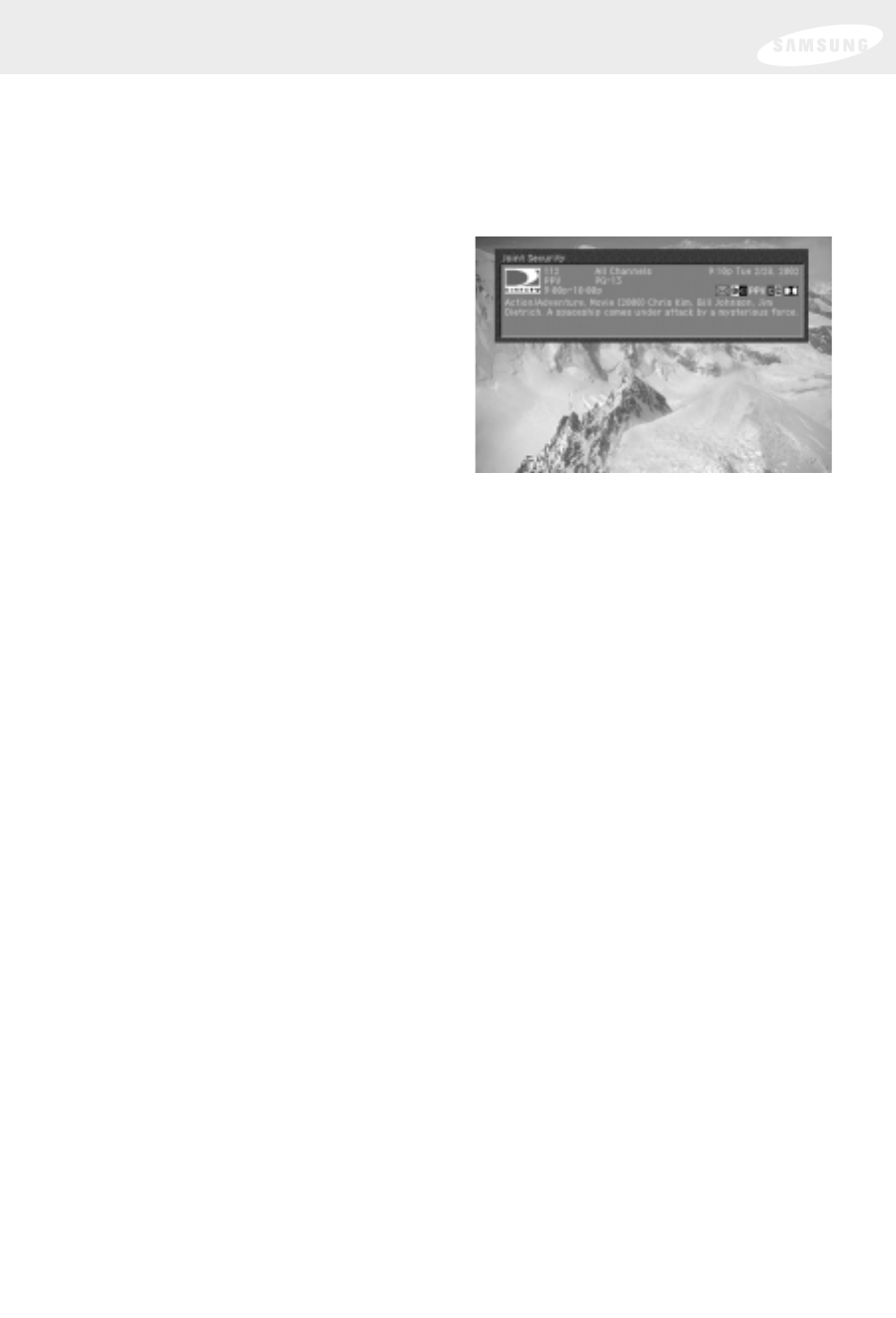
42
Chapter 3: Watching TV
The Full Channel Banner
The Channel Banner provides quick information about TV programs as you switch
channels on your DIRECTV Receiver. If you want to see information about the
channel you are currently watching, simply press the INFO button on your DIRECTV
Receiver’s remote control. Pressing the INFO button displays the Full Channel
Banner.
The Full Channel Banner displays all of the
information presented in the smaller
Channel Banner, plus a more detailed
description of the program. For example,
the Full Channel Banner for a movie might
display information about the category for
the movie (drama, comedy,
action/adventure, etc.), the cast, the year
it was released, and a short description of
the plot.
Note: If you change channels while viewing a Full Channel Banner, you will continue
to see Full Channel Banners (instead of the smaller Channel Banners) for each
channel you tune to.
Like the smaller Channel Banner, you can clear the Full Channel Banner from your
screen by pressing the EXIT button on your remote control.
Information icons
In addition to the basic channel and program information contained in the Channel
Banners (program title, channel name, rating, etc.), there are a set of information
icons. These icons tell you more about the program you are watching and about the
status of your DIRECTV Receiver. Here are descriptions of each icon:
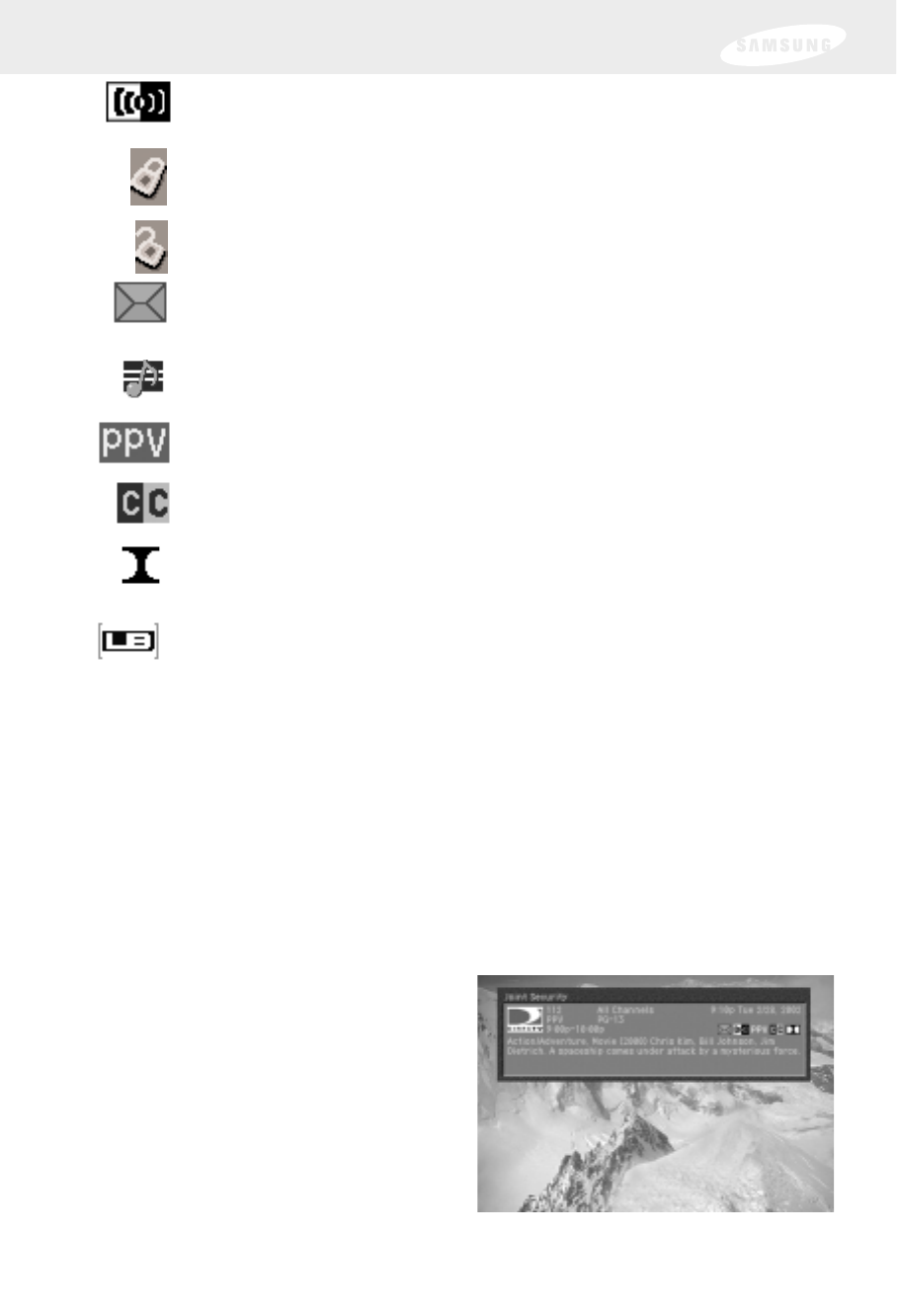
43
Chapter 3: Watching TV
Multi-language
This icon appears when additional audio tracks are available. Press the
yellow AUDIO button to choose an alternate audio track.
Locked
This icon appears when the system is locked.
Unlocked
This icon appears when the system is temporarily unlocked.
Mail
This icon appears when there are unread mail messages from DIRECTV in
your system mailbox.
Music channel
This icon appears when the channel is a music-only channel.
Pay per view program
This icon appears when the program is a pay per view program.
Closed caption
This icon appears when closed captioning is available for a program.
Dolby®Digital
This icon indicates that the current program is being broadcast using a
Dolby Digital audio track.
Letterbox
This icon indicates that the current program is being broadcast using the
letterbox widescreen video format.
The Program Detail Screen
If you want to see more information than is presented in either the Channel Banner
or the Full Channel Banner, you can press the INFO button twice to display the
Program Detail Screen.
The Program Detail Screen displays all of the information provided in the Channel
Banner and Full Channel Banner, plus complete details about the program and a list
of actions you can take related to the program.
To view the Program Detail Screen:
1While watching a TV program, press
the INFO button on your remote
control.
The Full Channel Banner appears.

44
Chapter 3: Watching TV
2Press the INFO button again.
The Program Detail Screen appears.
Another way to view the Program Detail screen is to enter the program Guide,
highlight the program listing you are interested in, then press the INFO button on
your remote control.
Program Detail Screen actions
In addition to providing a description of the program you are watching, the Program
Detail Screen provides a list of actions you can take related to that program.
Here are descriptions of all of the actions that might be available for a program.
(Note: not all actions are available for every program.)
Back: Displays the last screen you viewed before entering the Program
Detail Screen.
Exit: Clears the Program Details Screen and displays the last channel
you were viewing.
Buy $(Price) For pay per view programs, allows you to purchase the program.
Tape $(Price): For pay per view programs, allows you to purchase the program
and tape it on your VCR (appears only when the price to tape is
different from the purchase price).
Cancel $(Price): For pay per view programs that you have previously purchased
but that have not yet aired, lets you cancel your purchase.
Tune: Clears the Program Details Screen and displays the channel airing
the program described.
Schedule: For future programs, allows you to set your DIRECTV Receiver to
remind you when the program is about to start, or (model
SIR-S310W only) to set your DIRECTV Receiver and VCR to
record the program.
Unschedule: For programs you have previously scheduled for a reminder or
recording, allows you to cancel the reminder or recording.
Episodes: For programs broadcast as episodes, allows you to view a list of
other episodes in that program’s series.
Show Times: Displays a list of times and channels for viewing the program.
Similar: Displays a list of programs that have aspects in common with
the program.
Actions list
Select this arrow and press the
button to scroll down.
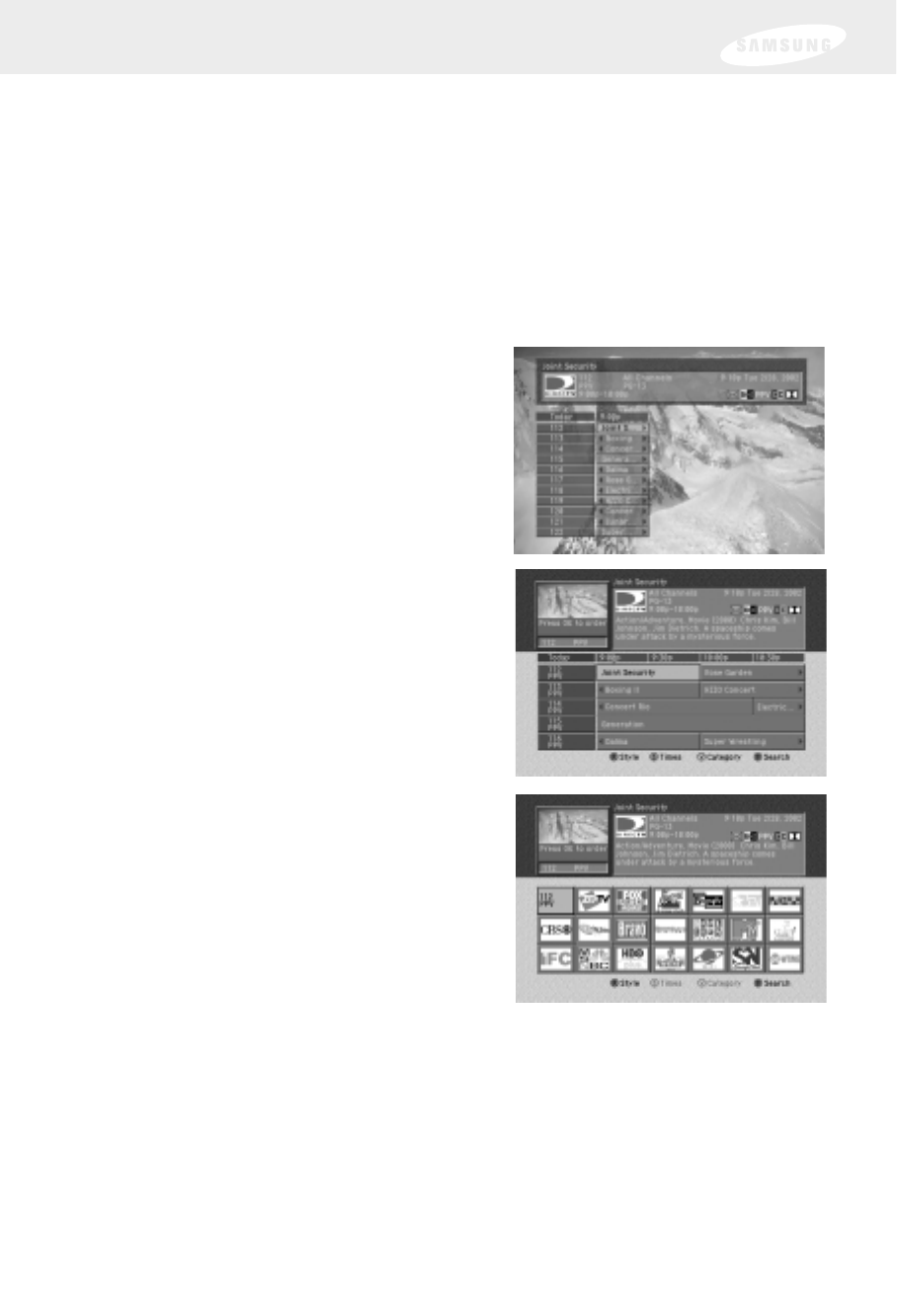
45
Chapter 3: Watching TV
Finding out what’s on: the Guides
Your DIRECTV Receiver provides access to detailed information about TV schedules.
If you want to know what’s on, just use the Guide.
There are several types of Guides you can access, each suited to a particular set of
needs and preferences.
Types of Guides
When you want to find out what’s on, you can use the simple, fast Quick Guide;
the detailed, informative Grid Guide; or the graphics-rich Logo Guide.
The pages that follow tell you how to access and use each of these Guide types.
Quick Guide
The Quick Guide allows you to quickly scan to
see what is on right now while still viewing the
channel you are watching. Great for those
times when you just want to quickly check out
what’s showing on that favorite channel.
Logo Guide
The Logo Guide lets you find out what’s on by
browsing through the channels by highlighting
the channels’ logos — perfect for those of us
who prefer pictures to text.
Grid Guide
The Grid Guide is the most complete, detailed
Guide type. It lets you see the programs for
each channel in a scrollable schedule (sorted
by channel number, or by channel name). If
you don’t know what you want to watch, and
you want to browse a broad range of
channels, the Grid Guide may be for you.
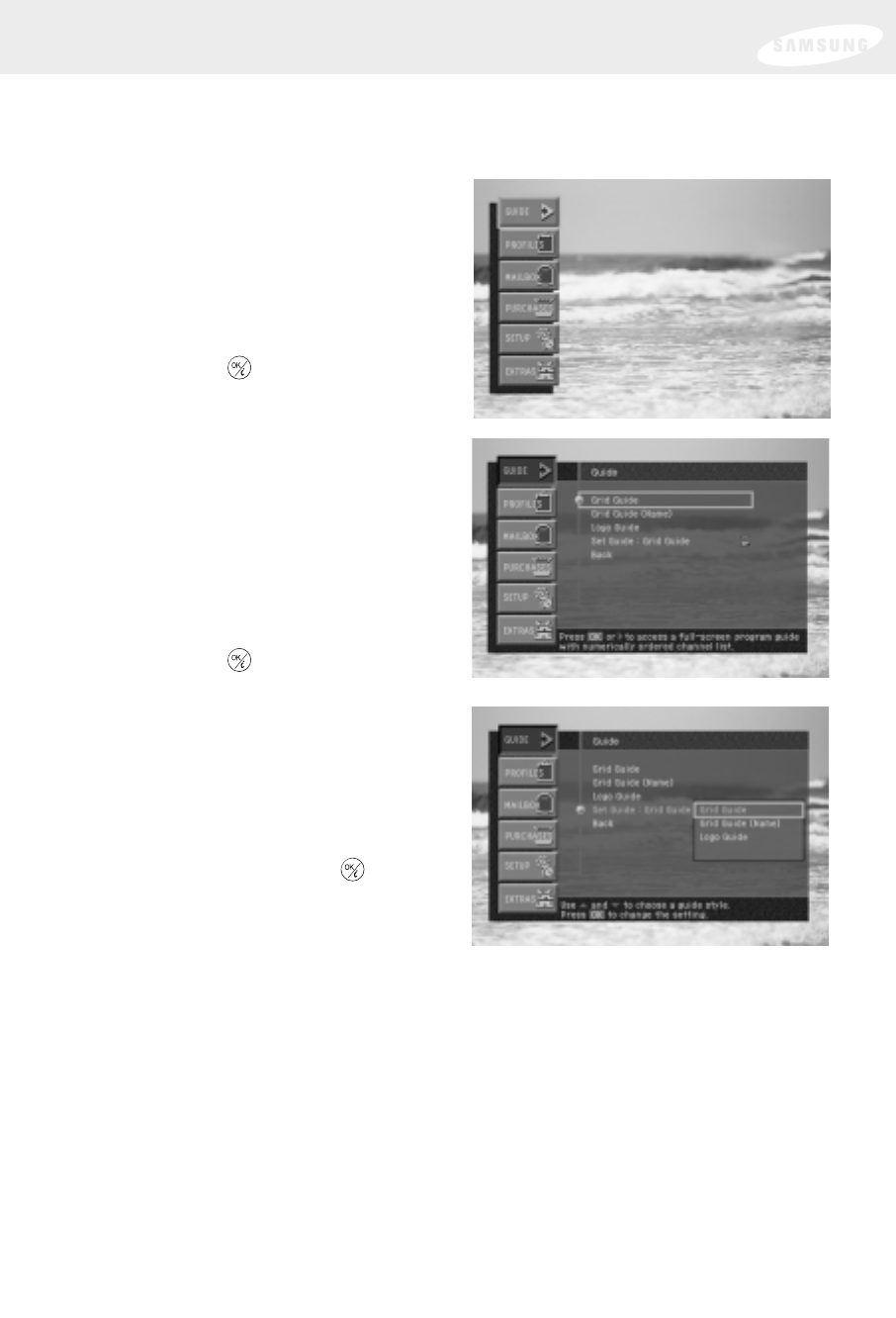
46
Chapter 3: Watching TV
Setting the default Guide style
The Guide menu item allows you to set which style of Guide is displayed when you
press the GUIDE button on your remote control. Here’s how:
1Press the MENU button on your
remote control.
The Main menu appears on your
screen.
When you display the Main menu,
the Guide item is highlighted.
2Press the button on your remote
control.
The Guide menu appears.
3Use the up- and down-arrow
buttons on your remote control to
highlight the Set Guide menu item.
The page icon to the right of the Set
Guide item indicates selecting this
item will display a list of options.
4Press the button on your
remote control.
A list of Guide Styles appears.
5Use the arrow buttons on your
remote control to select the Guide
style you wish to have displayed
anytime you press the GUIDE
button, then press the button.
The list of Guide styles disappears,
and the style you chose is displayed
in the Set Guide menu item.
6To exit the Menu, press the EXIT button on your remote control.
Pressing the GUIDE button will now display the Guide style you selected.
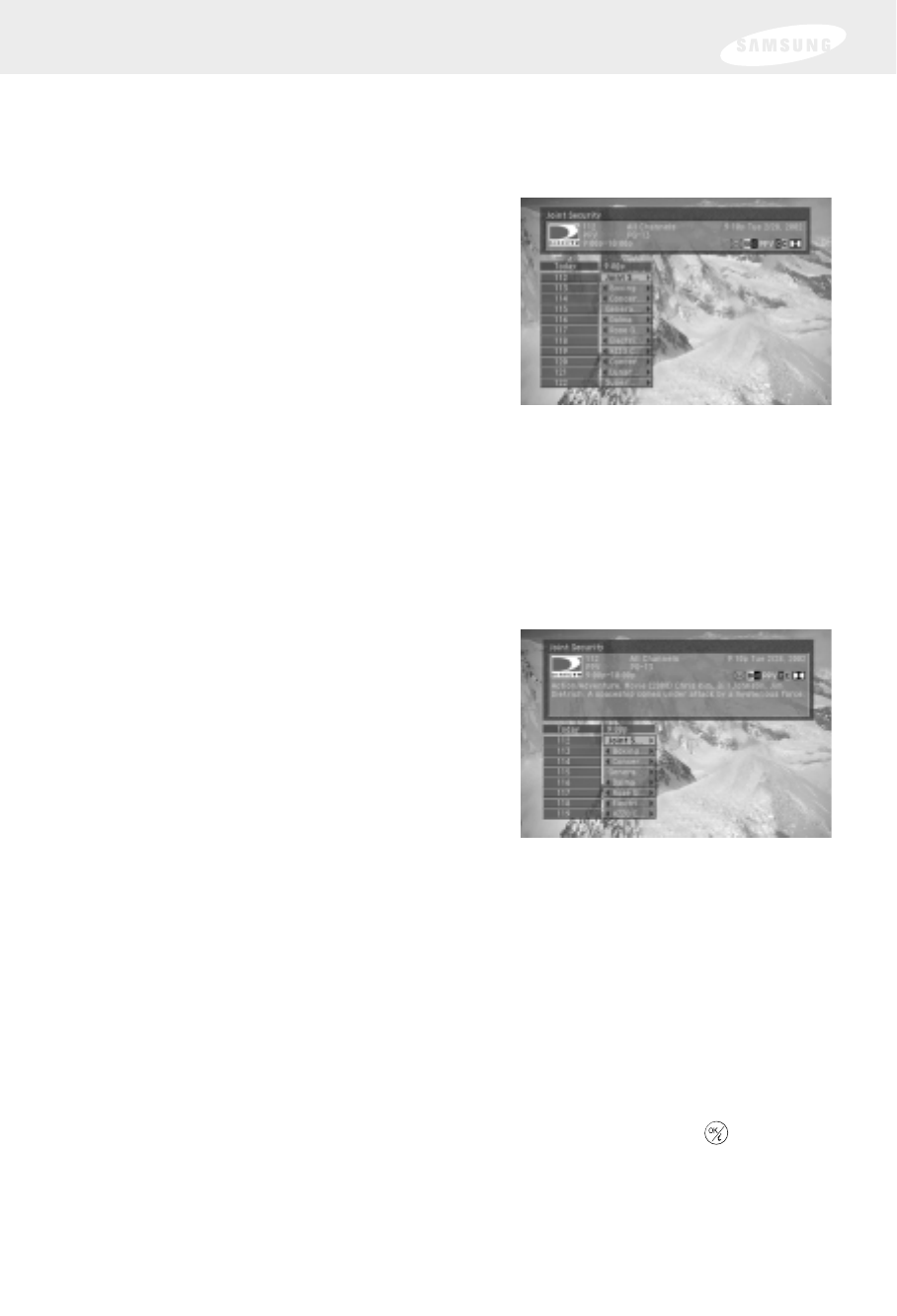
47
Chapter 3: Watching TV
Using the Quick Guide
The Quick Guide is made up of a Channel Banner and a channel list. This Guide is
small and transparent so that you can continue to watch a TV program while you
are browsing the Guide. Follow these steps to use the Quick Guide.
1To display the Quick Guide, press the
QUICK button on your remote control.
The Quick Guide appears, displaying
a small Channel Banner and a
channel list showing the current
half-hour time block.
2Use the arrow buttons on your remote control to move up or down in the
channel list, or forward (and then backward) in time. You can move up and
down through the channel list a full page at a time by pressing the CH+ and
CH- buttons on your remote control. You can also use the number buttons on
your remote control to move the Quick Guide directly to a specific channel.
As you highlight each program listing, its information appears in the Channel
Banner.
3To see more information on a highlighted
program, press the INFO button on your
remote control.
The Full Channel Banner appears. As you
browse the Quick Guide, the Full Channel
Banner will continue to be displayed. To
return to the smaller Channel Banner,
press the INFO button again.
4To get information on a channel (rather than a program), use the arrow keys
on the remote control to highlight the channel number.
The Channel Banner displays information about the highlighted channel.
5To expand the program listings to show more time, press the right-arrow
button on your remote control.
Each time you press the right arrow, the Quick Guide expands by 30 minutes
(up to a maximum 2-hour display). To reduce the Quick Guide in 30-minute
blocks, press the left-arrow button on your remote control.
6To watch a program you see listed in the Quick Guide, use the arrow buttons
on your remote control to highlight that program, then press the button.
The Quick Guide disappears, and the program you selected fills the screen.
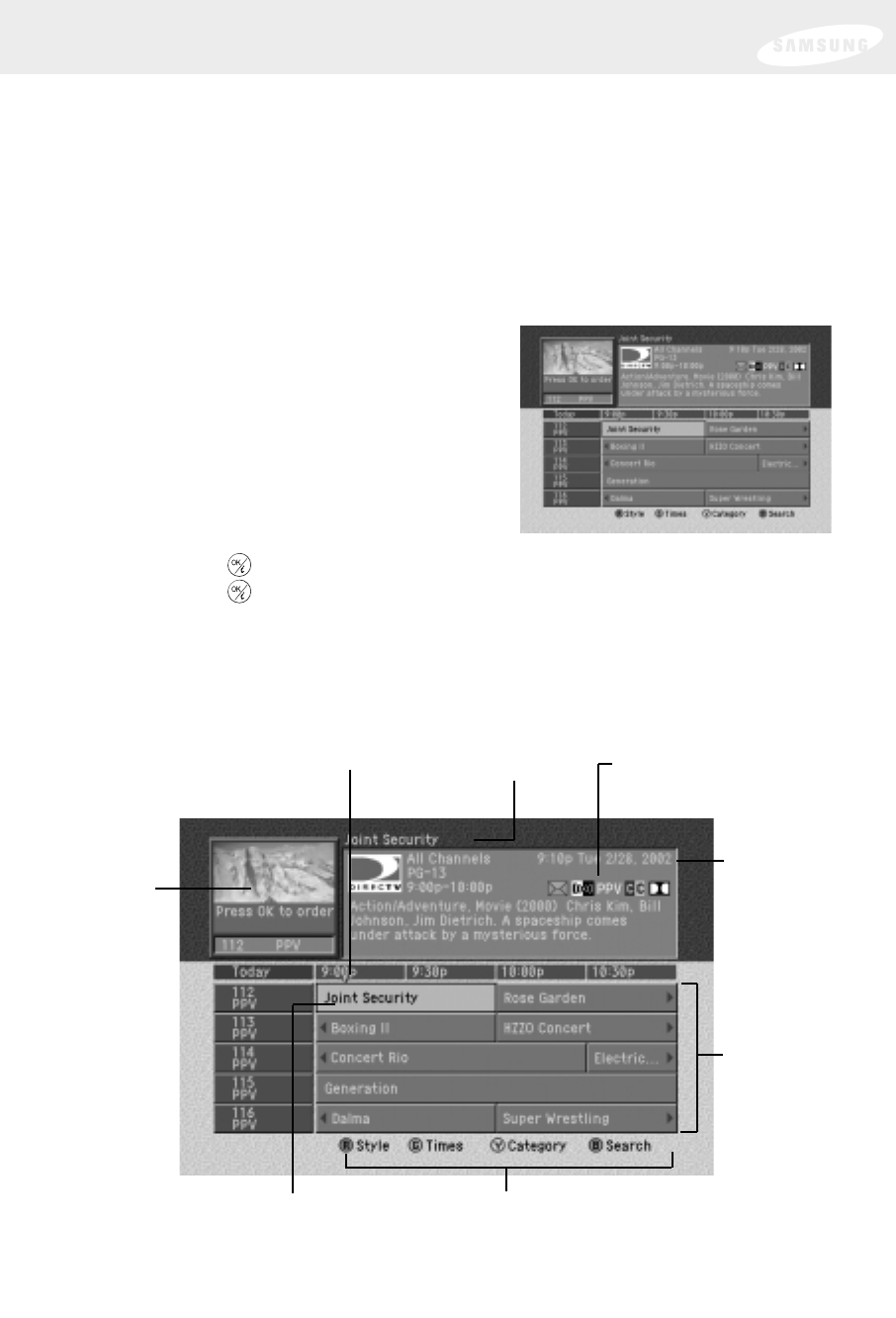
48
Chapter 3: Watching TV
Using the Grid Guide
The Grid Guide displays a Channel Banner and a channel list showing a 2-hour time
block for five channels (starting with the channel you are watching). It provides
access to the complete set of Guide features including the ability to search for
programs, schedule reminders and (on model SIR-S310W) recordings, etc.
Displaying and clearing the Grid Guide
To display or clear the Grid Guide:
1To display the Grid Guide, press the GUIDE button on your remote control.
The Grid Guide appears. (Pressing the
GUIDE button displays the Guide style —
Grid Guide, Grid Guide (Name), or Logo
Guide — established in the Set Guide
option in the Guide menu. The default
setting is Grid Guide).
2You can also display the Grid Guide by
pressing the MENU button on your
remote control. Then highlight Guide and
press the button on your remote control. Then highlight Grid Guide and
press the button again.
3To clear the Grid Guide from your screen, press the EXIT button on your
remote control..
Grid Guide overview
Picture-in-
Guide shows
you the
program you
are watching.
The program
list; use the
arrow buttons
on your remote
control to
highlight
different areas.
Icons to remind you about the Guide functions of the red,
green, yellow, and blue buttons on your remote control.
The program
currently highlighted.
Current time
and date
This diamond marks the current
time (so you can see how close you
are to a program start or end time).
This Banner shows
information about the
channel or program
highlighted in the Guide.
Title of the
highlighted program
or channel.
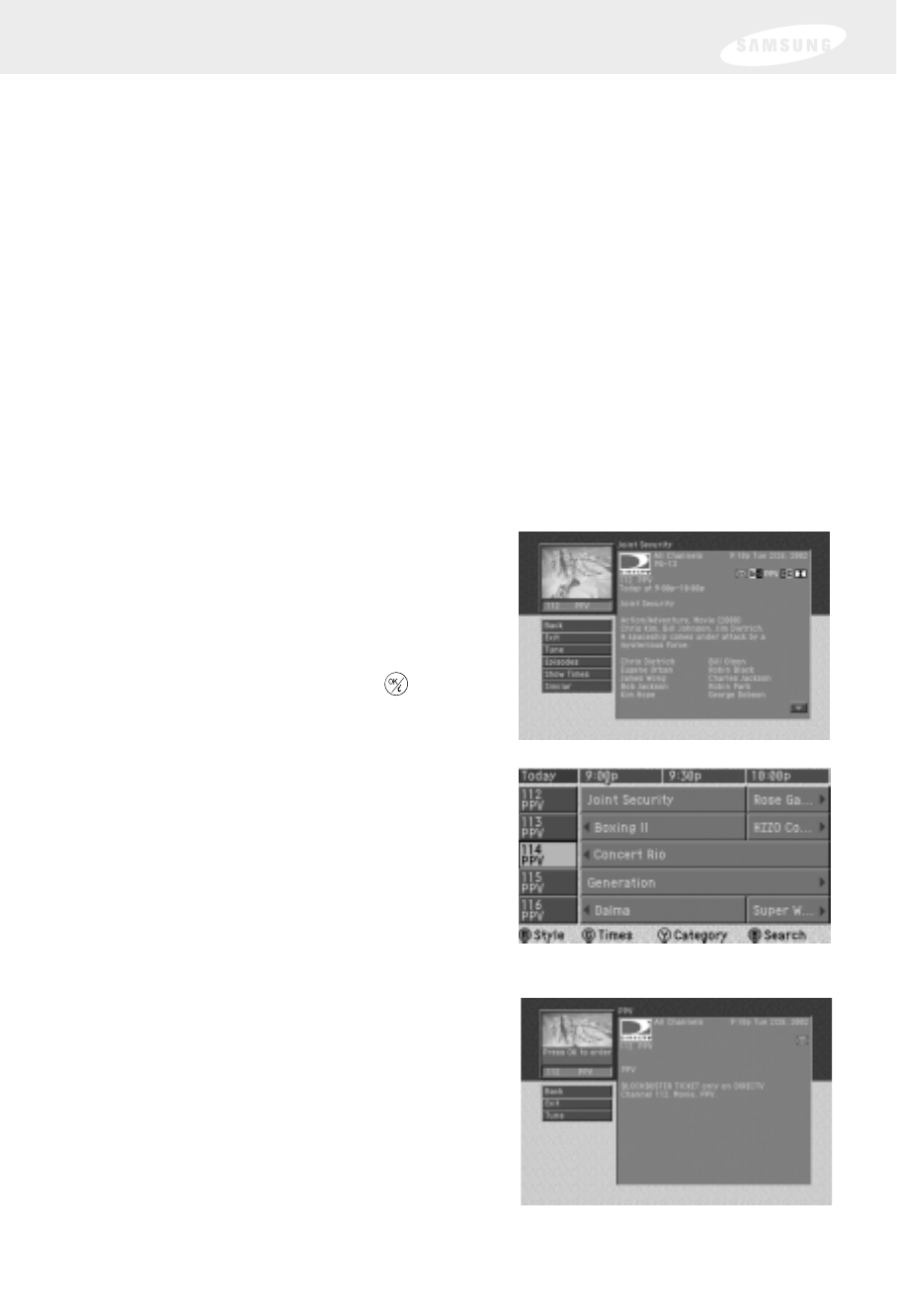
49
Chapter 3: Watching TV
Getting around in the Grid Guide
You can use the Grid Guide to get detailed information about the channels and
programs it contains. Here’s how:
1To highlight different program listings in the Grid Guide, use the arrow buttons
on your remote control to move up or down in the channel list, or forward and
backward in time.
Use the right-arrow button to see future program listings for up to 3 days on
model SIR-S300W, or up to 7 days on SIR-S310W.
2To move up and down through the channel list a full page at a time, press the
CH+ and CH- buttons on your remote control.
3To move the Grid Guide directly to a specific channel, press the 0-9 number
buttons on your remote control to enter the desired channel number.
4As you highlight each program listing in the Grid Guide, information about the
program appears in the Channel Banner. To see more information on a
highlighted program, press the INFO button on your remote control.
The Program Detail screen appears,
showing complete information about the
highlighted program and a list of actions
you might want to take related to
that program. To return to the Grid Guide,
highlight the Back item from the
on-screen list and press the
button on your remote control.
5To get information on a channel (rather
than a program), use the arrow keys on
the remote control to highlight the
channel entry in the Guide.
The Channel Banner displays information
about the highlighted channel.
6Press the INFO key on your remote
control while a channel entry is
highlighted to see a Channel Detail Screen
containing more information about the
highlighted channel.
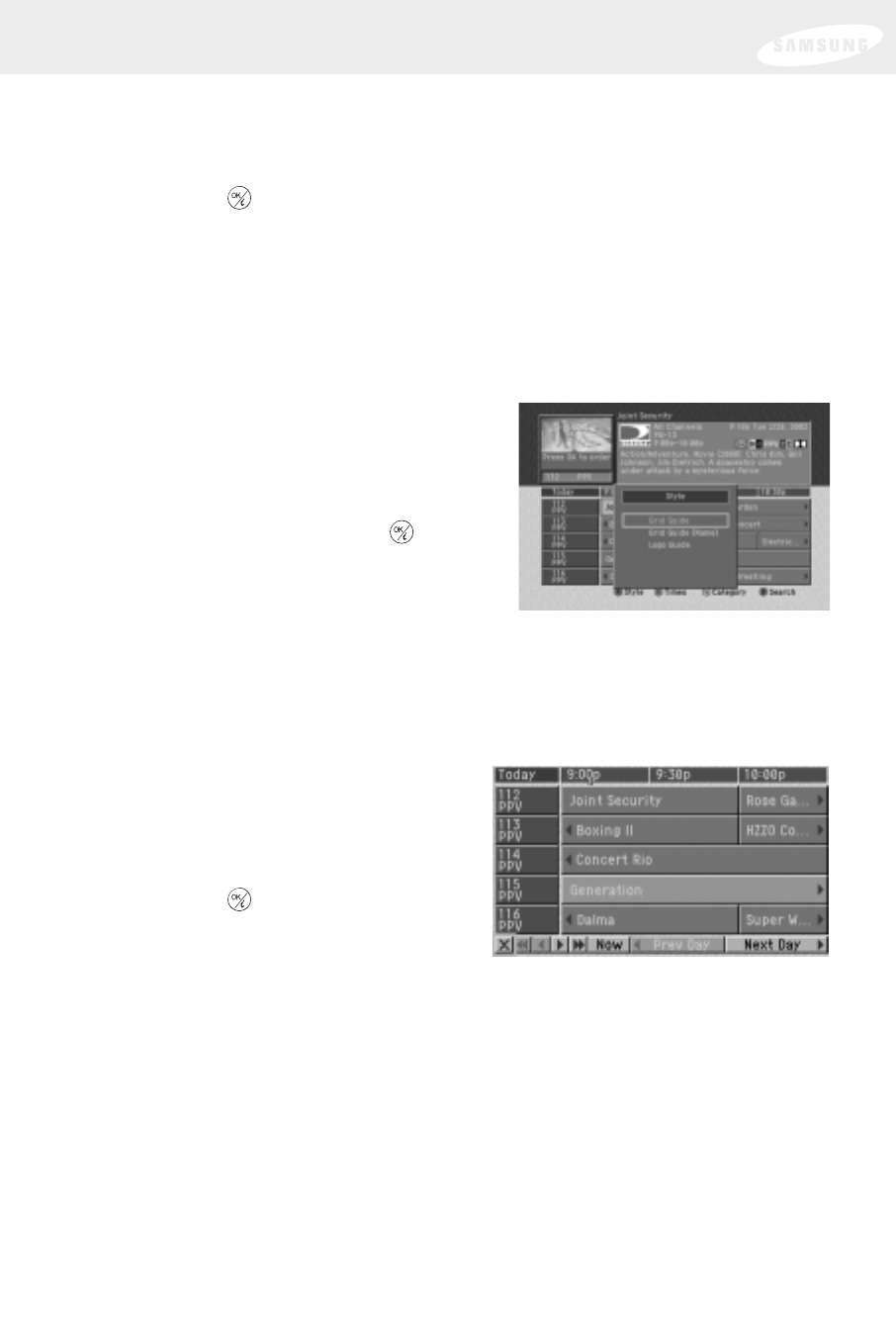
50
Chapter 3: Watching TV
Tuning to a channel with the Grid Guide
To tune to a program or channel listed in the Grid Guide:
1Use the arrow keys to highlight the program or channel you want to watch.
2Press the button on your remote control.
The Guide disappears, and the channel you selected fills the screen.
Switching to another Guide style
You can switch from the Grid Guide to the Grid Guide (Name) or Logo Guide while
viewing the Grid Guide. Here’s how:
1With the Guide displayed on your screen, press the red R button on your
remote control.
A list of Guide Styles appears on your
screen.
2Use the arrow buttons on your remote
control to highlight the Guide style you
wish to view, then press the button.
The Guide Style list disappears, and the
Guide appears in the style you chose.
Viewing the Guide for a different time
You can view the TV programming for different times by using the Guide’s time
control bar. Here’s how:
1With the Guide displayed on your screen, press the green G button on your
remote control.
The time control bar appears across
the bottom of the Guide.
2Use the arrow buttons on your remote
control to highlight the time controls.
Press the button to select the
controls you wish to use.
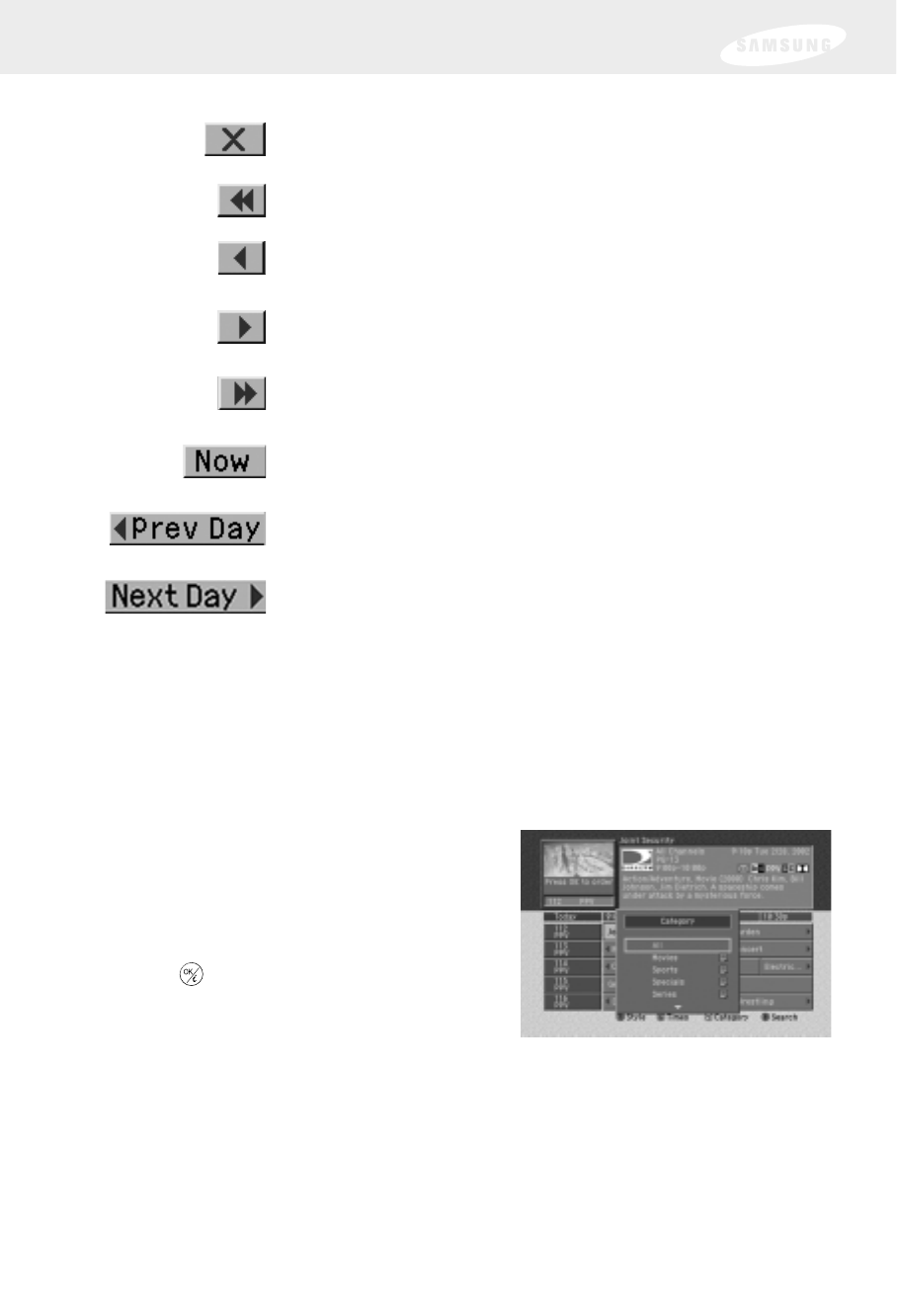
51
Chapter 3: Watching TV
Here is an explanation of each time control.
Viewing a category of programs in the Guide
You can set your Guide to show you all channels, or only channels showing
programs in a specific category (for example, only channels showing sports, or only
channels showing movies). Here’s how:
1With the Guide displayed on your screen, press the yellow Y button on your
remote control.
A list of Guide Categories appears on
your screen.
2Use the arrow buttons on your remote
control to highlight the Guide category
you wish to view, then press
the button.
The Guide Category list disappears and
the Guide appears, displaying channels
showing programs that match the
category you chose.
Exits the time control bar.
Moves the Guide view back 6 hours (unavailable when
viewing the current time).
Moves the Guide view back 30 minutes (unavailable
when viewing the current time).
Moves the Guide view ahead 30 minutes.
Moves the Guide view ahead 6 hours.
Moves the Guide view to the current time.
Moves the Guide view back 24 hours (unavailable when
viewing the current time).
Moves the Guide view ahead 24 hours.
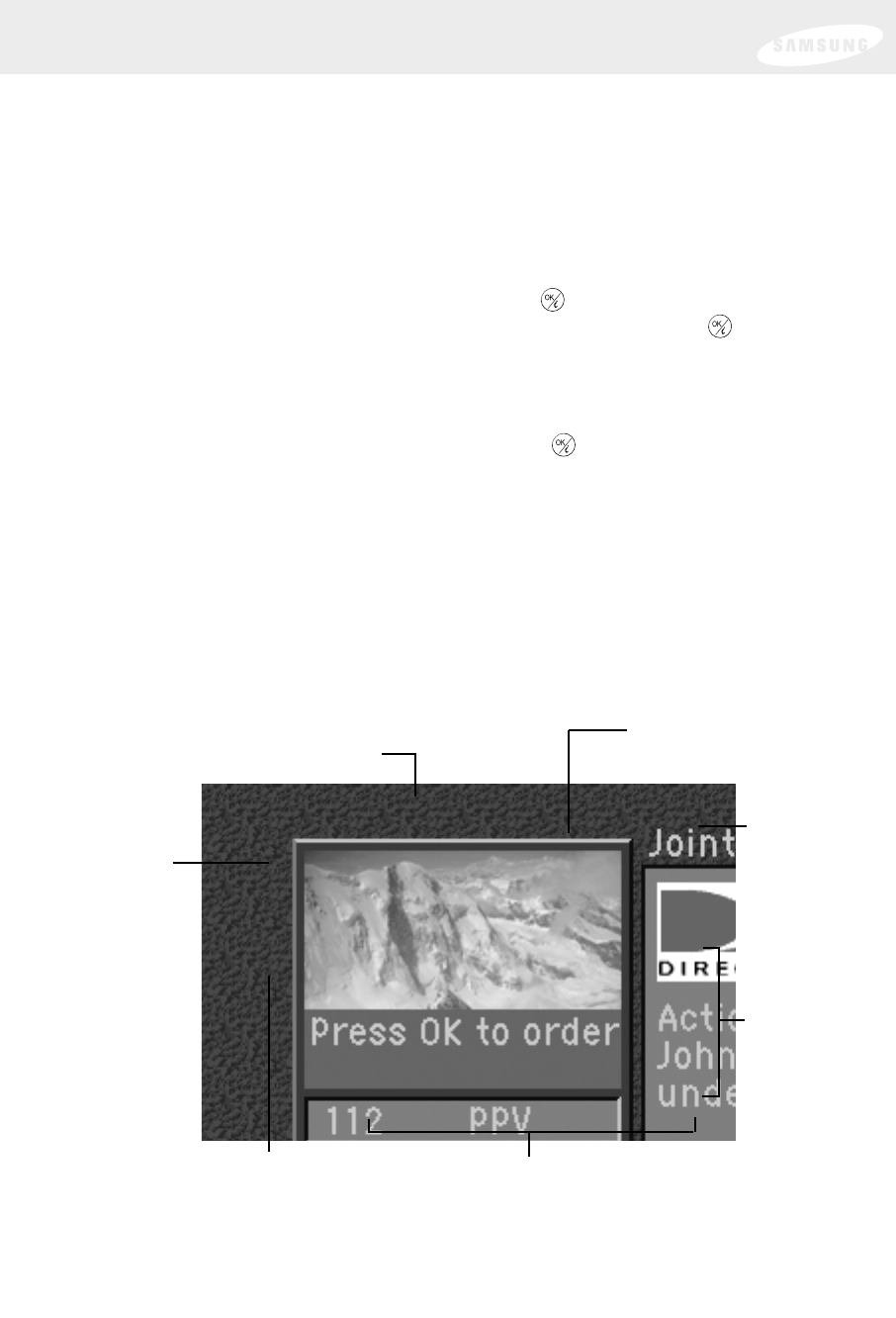
52
Chapter 3: Watching TV
Using the Logo Guide
The Logo Guide displays 21 channel logos and a Channel Banner showing
information about the program currently showing on the highlighted channel.
Follow the steps in this section to use the Logo Guide.
Displaying and clearing the Logo Guide
To display or clear the Logo Guide:
1Press the MENU button on your remote control. Then use the arrow buttons to
highlight the Guide menu item, and press the button on your remote
control. Then highlight the Logo Guide menu item, and press the button.
The Logo Guide appears on your screen.
2Or, press the GUIDE button on your remote control. Then press the red R
button to display the list of Guide styles. Then use the arrow buttons to
highlight the Logo Guide option, and press the button on your remote
control. The Logo Guide appears.
3Or, you can set the default Guide Style so that the Logo Guide always appears
whenever you press the GUIDE button on your remote control. See Setting the
default Guide style on page 46 for details on setting the default Guide Style.
4To clear the Logo Guide from your screen, press the EXIT button on your
remote control.
Logo Guide overview
Picture-in-Guide
shows you the
program you
are watching.
The channel
logo list; use
the arrow
buttons on
your remote
control to
highlight
different logos.
These icons remind you about
the Guide functions of the red,
green, yellow, and blue buttons
on your remote control.
The channel
currently
highlighted.
Current time
and date
This Banner shows
information about
the program
showing on the
highlighted channel.
Title of the program on
the highlighted channel.
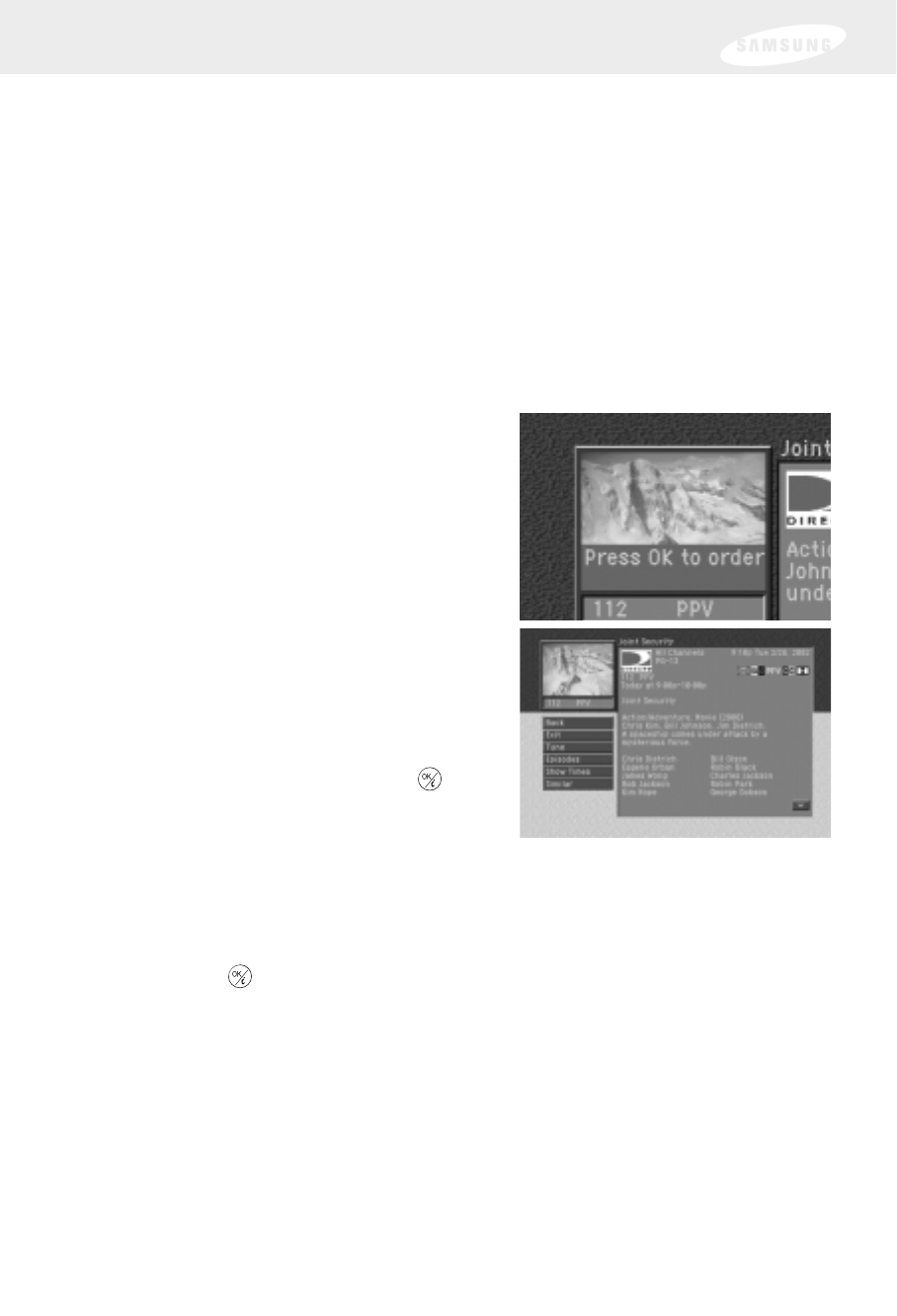
53
Chapter 3: Watching TV
Getting around in the Logo Guide
You can use the Logo Guide to get information about the programs currently
showing on your DIRECTV Receiver. Here’s how:
1To highlight different program listings in the Logo Guide, use the arrow buttons
on your remote control to move up, down, left, or right in the logo list.
When you highlight a logo, it is replaced by the channel name and number in
the Logo Guide.
2To move up and down through the channel logos a full page at a time, press
the CH+ and CH- buttons on your remote control.
3To move the Logo Guide directly to a specific channel, press the 0-9 number
buttons on your remote control to enter the desired channel number.
4As you highlight each channel logo in
the Logo Guide, information about the
program currently showing on the
highlighted channel appears in the
Channel Banner. To see more
information on a highlighted program,
press the INFO button on your
remote control.
The Program Detail Screen appears,
showing complete information about the
program on the highlighted channel, and
a list of actions you might want to take
related to that program. To return to the
Logo Guide, highlight the Back item from
the on-screen list and press the button
on your remote control.
Tuning to a channel with the Logo Guide
To tune to a program or channel listed in the Logo Guide:
1Use the arrow keys to highlight the channel you want to watch.
2Press the button on your remote control.
The Logo Guide disappears, and the channel you selected fills the screen.

54
Chapter 3: Watching TV
Switching to another Guide style
You can switch from the Logo Guide to the Grid Guide or Grid Guide (Name) while
viewing the Guide. Here’s how:
1With the Guide displayed on your screen, press the red R button on your
remote control.
A list of Guide Styles appears on
your screen.
2Use the arrow buttons on your remote
control to select the Guide style you wish
to view, then press the button.
The Guide Style list disappears, and the
Guide appears in the style you chose.
Searching for programs in the Guide
You can search the entire list of programs stored in your DIRECTV Receiver’s
program guide to find exactly the program you wish to see. There are four ways to
search the Guide:
By Credits: Lets you find programs that match the actor, director, role, award,
or year you type using an on-screen keyboard.
By Title: Lets you find programs that match the program title you type using
an on-screen keyboard.
By Text: Lets you find programs for which either the credits or the title
match the search term you type using an on-screen keyboard.
By Category: Lets you find programs that match the program categories and sub-
categories you select from an on-screen list.
These search techniques are described in the sections that follow.